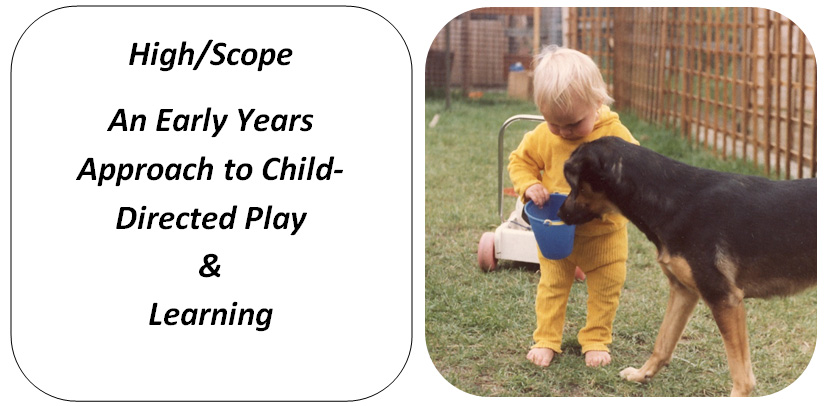 The relationship between the development of language and the development of thinking and reasoning embraces issues of communication, generalisation and socialization.
‘One of man’s most distinctive characteristics is his ability to use language. It permits him to behave more intelligently by tying together the past, present, and future. It captures concepts which are useful in solving problems.’ (Bernard1965:161)
The relationship between the development of language and the development of thinking and reasoning embraces issues of communication, generalisation and socialization.
‘One of man’s most distinctive characteristics is his ability to use language. It permits him to behave more intelligently by tying together the past, present, and future. It captures concepts which are useful in solving problems.’ (Bernard1965:161)
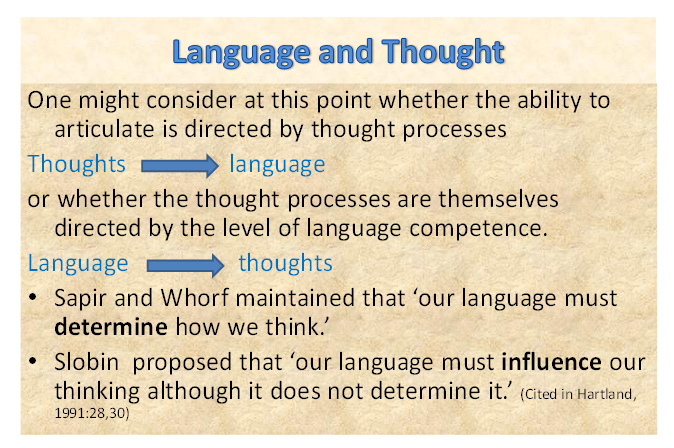 Contents
Introduction
Contents
Introduction
- Engaging in Active Communication page 4
- Closed Questions page
- Open Questions
- The Development of Autistic Thinking, Egocentric Thought & Communicative Speech
- Cognitive Goals of Thinking
- Positive Adult-Child Interactions
- Planning Time – (Planning)
- Work Time – (Doing) Recall Time – (Reviewing)
- Small Group Time
- Large Group Time
- Outside Time
- Transition Times
- Supporting Children in Resolving Conflict,
- Plan -Do-Review
Introduction
High/Scopeevolved as a practice based on the following three areas of study: practical interpretation of Piaget, observations of children, and traditional nursery school practices. The adult’s role is predominantly informal with an emphasis on listening to the speech of the child, respectfully participating in the child’s pretend and role playing activities, and creatively supporting language development, which includes a special emphasis on verbal reflection of the child’s activities and disposition. (DVD,1986) The following quote describes the three basic criteria which initiated the High/Scope preschool education programme. 1 ‘A coherent theory about teaching and learning must guide the curriculum development process. 2 Curriculum theory and practice must support each child’s capacity to develop individual talents and abilities through ongoing opportunities for active learning. 3 The teachers, researchers and administrators must work as partners in all aspects of curriculum development to ensure that theory and practice receive equal consideration.’(Hohmann, 2002:4) The High/Scope approach presents that:-- ‘learning comes from within’
- ‘personal initiative ‘directs the child’s active learning
- Control needs to be shared between the adults and children
- The adults do not dominate, direct or overpower the child’s choices of activity and emergent style of learning.
- Maturation and experience
- ‘Learning oral language depends on good models, having something to communicate, and emphasis on the positive.’(Bernard1965:161)
- Motivation
- ‘Language not only provides a vehicle for communication, but it aids in the acquisition and preservation of new ideas.’ (Bernard,1965:148)
- Language skills
- ‘..... how complex are the functions of language, and how futile the attempt to reduce them all to one – that of communicating thought.’ (Piaget,1956:2)
- Social cooperation and social communication
- ‘Social organization is formed through communication, and its’ stability depends on facility in communication. ‘(Bernard1965:148)
- ‘Each function in the child’s cultural development appears twice: first, on the social level, and later, on the individual level; first, between people, and then inside the child.’ (Cited in Nelson,1996:19)
- Interpretation - analyses and synthesis
- ‘All of reasoning depends on information as well as on brain power necessary to utilise that information.’ (Bernard,1965:65)
- Sensory perception, habits and skills
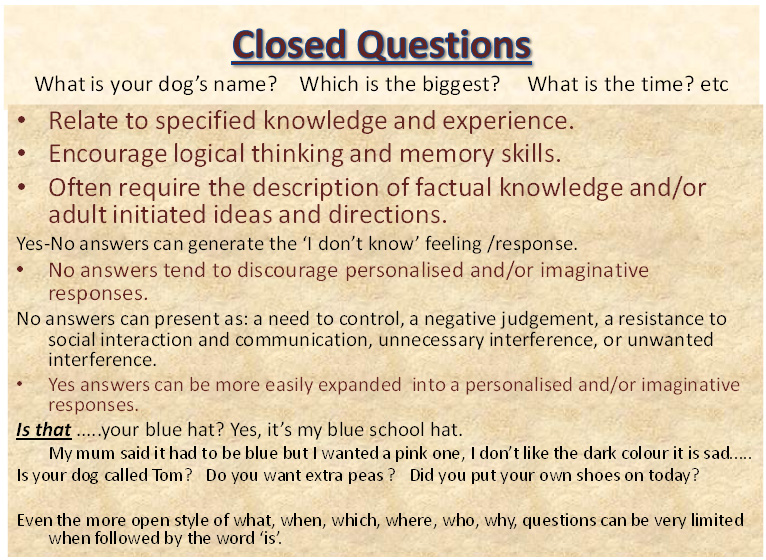
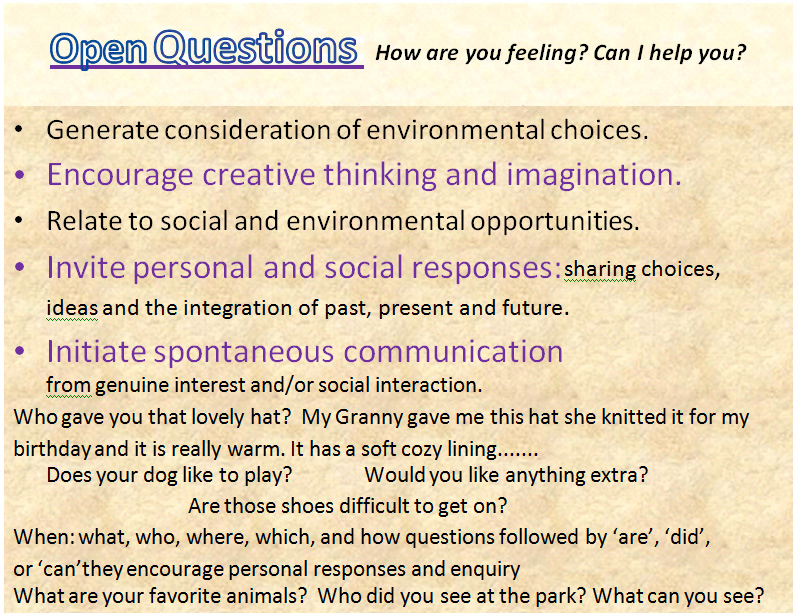
Choice and Adult Participation
The High/Scope methods also appear to emphasize the important influences that cultural experiences have upon the young child’s development of language and relationship to thought. This is illustrated in the daily High/Scope timetable which supports the children’s own responsibility for choosing what they want to do yet, at the same time, presents different social dynamics with specified adult participation: e.g. environmental enrichment guided by adult observations of the children, and activities that offer specified variations in group size and style of socialization.Young children are encouraged to share their play with the adults and clearly direct how they wish the adult to participate within their games.The adult may illustrate their companionship and attention as follows:- Positive Listening and Communication Skills- Passive Listening including appropriate eye contact and reassuring physical gestures/contact/holding
- Active participation through parallel or co-operative modes of interactive play.
- Active Listening.
- Reflection (Reflective Feedback)
- Awareness and focused attention
- Enhanced association of knowledge
- Ability to evaluate sensory information
- Development of thinking and hypothesis
- Assessment of determining factors and appropriate redirection
- Long and Short-term memory
- Non pressurised self-directed learning
- Extending Observing the child’s play and supporting with the provision and organisation of environmental materials and subsequent enriching follow-up activities.
- Affirmation of success
- Repetition (echolalia) – when verbal stimulus of syllables/words is imitated for the pleasure of talking and is ‘obviously devoid of any social character’.
- Monologue- ‘the child talks to himself as though he were thinking aloud.’
- Duel or collective monologue- where an outsider is somehow associated with the child’s spoken words, and yet the outsider’s presence serves only as a stimulus because he is not expected either to attend or understand what has been spoken.(Piaget,1956:9)
- Adapted information - a real exchange of thoughts, collaboration or simple dialogue, whereby the child speaking presents information that adopts the point of view of his hearer and thereby gains interest or influence.
- Criticism- ‘all remarks made about the work or behaviour of others’ these remarks often ‘asserted a superiority’ and ‘depreciated others’.
- Commands, Requests and Threats- where there is a definite interaction between one child and another.
- Questions- that called for an answer.
- Answers -when presented as a response to a genuine question.(Piaget,1956:10,11,21)
The Development of Autistic Thinking, Egocentric Thought and Communicative Speech
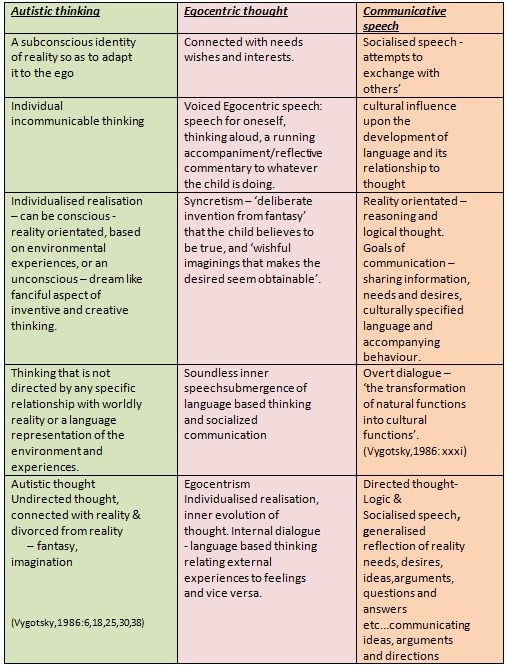
- personalised relationship with reality,
- conceptual meaning of words,
- spoken communication. (Vygotsky’s,1986)
 Vygotskysuggests that educational approaches to the child’s development of language and thought ‘must be built upon three concepts: higher mental functions, cultural development, and mastering one’s own behavioural processes’,motivation, maturation and experience.Vygotsky proposes that ‘specifically human forms of psychological communication are possible because man’s reflection of reality is carried out in generalized concepts’ (Vygotsky,1986:Xxix,8)
Blooms describes the highest thinking skills as ‘Cognitive Goals of Thinking’:-
KNOWLEDGE COMPREHENSION APPLICATION ANALYSIS SYNTHESIS EVALUATION (Cited in Fisher, 1990:69)
In the chart below the author has added some proposed earlier thinking skills and some descriptive notes:-
Vygotskysuggests that educational approaches to the child’s development of language and thought ‘must be built upon three concepts: higher mental functions, cultural development, and mastering one’s own behavioural processes’,motivation, maturation and experience.Vygotsky proposes that ‘specifically human forms of psychological communication are possible because man’s reflection of reality is carried out in generalized concepts’ (Vygotsky,1986:Xxix,8)
Blooms describes the highest thinking skills as ‘Cognitive Goals of Thinking’:-
KNOWLEDGE COMPREHENSION APPLICATION ANALYSIS SYNTHESIS EVALUATION (Cited in Fisher, 1990:69)
In the chart below the author has added some proposed earlier thinking skills and some descriptive notes:-
Cognitive Goals of Thinking

- ‘Direct action on objects,
- Reflection on actions,
- Intrinsic motivation, invention and generativity,
- Problem solving. ‘....direct and immediate experiences and deriving meaning from them through reflection-young children construct knowledge that helps them to make sense of their world.’
- When children are ‘supported by adults who are genuinely interested in what they say and do children are able to construct their own understanding of the world around them and gain a sense of control and personal satisfaction.....’This emphasis on Adult-Child socialization is focused on participation, listening and sharing. Young children share their play with the adults, the children clearly direct how they wish the adult to participate within their games(Hohmann,2002:10)
- Planning Time– (Planning)
- Work Time–(Doing)
- Recall Time–(Reviewing)
- Small Group Time
- Large Group Time
- Outside Time
- Transition Times
- Approach quickly and calmly onto the children’s level, interrupt any hurtful behaviour and use the physical body to block any aggressive actionsand prevent any further antisocial action. Receive and initiate eye contact in a natural and appropriatemanner with each individual child. (Minimal language communication within a mood of gentleness and a sense of quiet)
- Acknowledge the children’s situation using simple statementsthat reflect the spontaneous speech of the child, give comments and present insightful questions. (Reflecting)
- Gather information listening very carefully to what the children say give each child plenty of time to communicate successfully. (Listening and Reflecting)
- Restate the problemusing as much of the children’s language as possible and rephrasing anything that could be hurtful or negatively judgmental. Help each individual child to clarify his own feelings and perspective on the problem. (Recapping and Reflection)
- Ask for ideas for solutions and support the children in coming to an agreement on a chosen solution and specify the practical steps to implement this solution. (Occasional Open-Ended Questions, Listening and Reflecting.)
- Be prepared to give follow-up support. Review what happened and if the problem has not been successfully resolved return to the point of the procedure that remains unresolved.(Listening, Reflecting, Recapping, and an occasional Question)
Plan -Do-Review
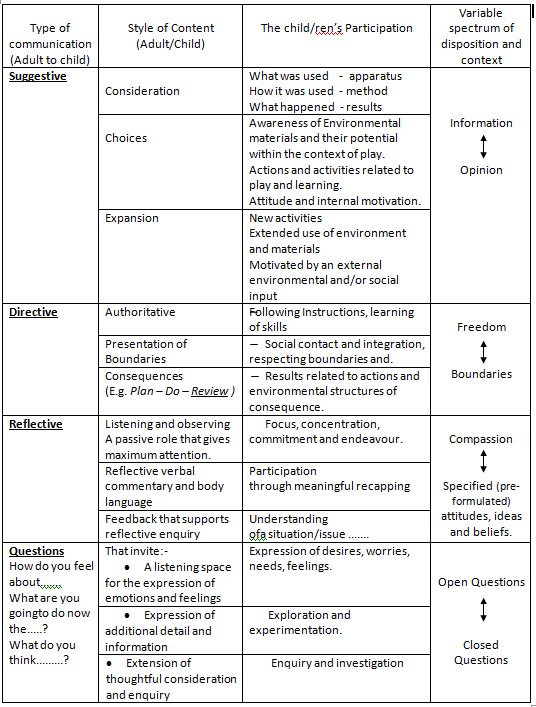
 The concluding chart summarises the High/Scope approach to supporting/scaffolding children’s development during their early years within a play and learn philosophy.
The concluding chart summarises the High/Scope approach to supporting/scaffolding children’s development during their early years within a play and learn philosophy.
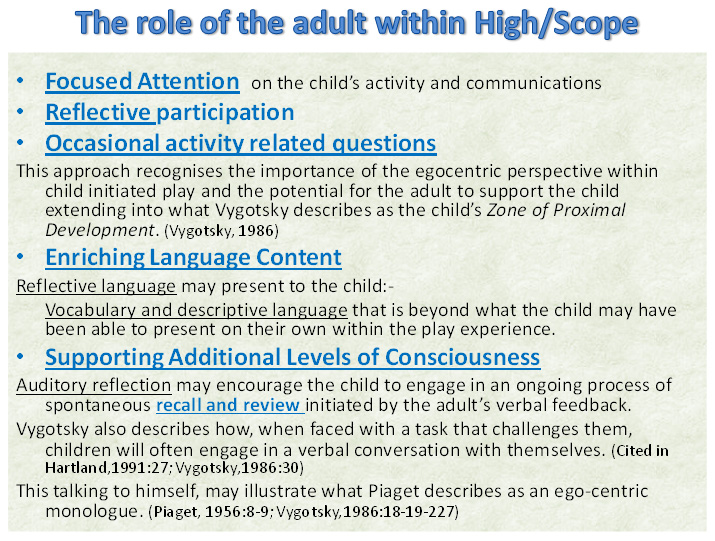 Bibliography High/scope Education
Athey, C. Extending Thought in Young Children. London: Paul Chapman, 2007.
Bernard,H.W. Psychology of Learning and Teaching (2nd Ed). New York: McGraw-Hill, 1965.
Hartland, J. Language and Thought. Leicester: British psychological society, 1991.
Hohmann, M. and Weikart, D.P. Educating Young Children(2nd Ed.) Ypsilanti: High/Scope Press, 2002.
King, P.M. &Strohm Kitchener, K. Developing Reflective Judgement. San Francisco: Jossey-Bass, 1994.
Nelson, K. Language in Cognitive Development. Cambridge: Cambridge University Press, 1996.
Overall, L. Supporting Children’sLearning. London: Sage Pub, 2007.
Piaget, J. The Language and Thought of the Child (3rd Ed).London: Routledge & Kegan Paul LTD, 1956.
Pinney, R. Creative Listening(5th Ed.) London: Children’s Hours Trust, 1992.
Pinney, R. Children’s Hours (2nd Ed) London: Children’s Hours Trust, 1990.
Roopnarine, J. L. and Johnson, J. E. Approaches to Early Childhood Education (4th Ed.) New Jersey: Pearson Prentice Hall, 2005.
Schon, D. A. The Reflective Practitioner.Ashgate: 1991.
Taylor, L. Introducing Cognitive Development. Hove: Psychology Press, 2005.
Vygotsky, L. Thought and Language. London: The MIT press, 1986.
Weikart, D.P. &Hohmann, M. Educating Young Children (2nd Ed.)Michigan : High/Scope Press, 2002.
Wood, D.How Children Think and Learn. Massachusetts: Blackwell Pub, 1988.
Bibliography High/scope Education
Athey, C. Extending Thought in Young Children. London: Paul Chapman, 2007.
Bernard,H.W. Psychology of Learning and Teaching (2nd Ed). New York: McGraw-Hill, 1965.
Hartland, J. Language and Thought. Leicester: British psychological society, 1991.
Hohmann, M. and Weikart, D.P. Educating Young Children(2nd Ed.) Ypsilanti: High/Scope Press, 2002.
King, P.M. &Strohm Kitchener, K. Developing Reflective Judgement. San Francisco: Jossey-Bass, 1994.
Nelson, K. Language in Cognitive Development. Cambridge: Cambridge University Press, 1996.
Overall, L. Supporting Children’sLearning. London: Sage Pub, 2007.
Piaget, J. The Language and Thought of the Child (3rd Ed).London: Routledge & Kegan Paul LTD, 1956.
Pinney, R. Creative Listening(5th Ed.) London: Children’s Hours Trust, 1992.
Pinney, R. Children’s Hours (2nd Ed) London: Children’s Hours Trust, 1990.
Roopnarine, J. L. and Johnson, J. E. Approaches to Early Childhood Education (4th Ed.) New Jersey: Pearson Prentice Hall, 2005.
Schon, D. A. The Reflective Practitioner.Ashgate: 1991.
Taylor, L. Introducing Cognitive Development. Hove: Psychology Press, 2005.
Vygotsky, L. Thought and Language. London: The MIT press, 1986.
Weikart, D.P. &Hohmann, M. Educating Young Children (2nd Ed.)Michigan : High/Scope Press, 2002.
Wood, D.How Children Think and Learn. Massachusetts: Blackwell Pub, 1988.
Acknowledging Our Daily Experiences
Love, freedom and safety, The foundations for movement. Movement - The Foundations for Play, Play - Foundations for Learning. Learning - Foundations for Intelligence Intelligence - Foundations for Personal Empowerment Empowerment - Foundations for Heart-full Living Heart-full Living - Foundations for the Engagement of the soul. Engagement of the Soul – Revival of Higher Consciousness Higher Consciousness - Foundations for Communion with God Communion with God – The Supreme source of Love and Light Love and Light – Living the Dream of Heaven on Earth12 Points for Encouraging Child-Directed Learning
1) Encourage exploration and personal discovery rather than showing the learner how to do something or giving the answers. 2) The Emotional environment is as important as the intellectual environment. Children are often more aware of our inner feelings than we are ourselves. A young child’s safety may depend upon how well he can assess the adult carer’s mood and emotional disposition. The child’s happiness is directly related to the happiness felt and expressed by his carer. An unhappy adult who is denying his/her unhappiness is unlikely to be able to sustain the happiness and wellbeing of the young child. Intimacy demands a level of authenticity beyond that needed for everyday living. Authenticity is essential to our ability to relate socially and safely with each other. 3) Trust the child will know the right time to begin learning formal skills. For example children who begin reading later than considered normal, have developed greater comprehension skills and faster reading speeds than other children who learned to read earlier. 4) Ask a leading question instead of giving the answer. Example: Child: How do you spell sat Adults: What is difference between sat and bat? Child: Bat starts with ‘b’. Adult: What sound does sat start with? Child: Sat starts with ‘s’ Adult: Could you now have a go at spelling sat? If the child and adult helper cannot find a successful way of establishing a discovery learning approach, it would normally suggest that the child is venturing beyond their present learning potential. When the adult does something for the child, without engaging in a shared learning process, then the child moves away from his/her learning potential and thereby becomes increasingly dependent upon the adult’s superior level of ability. When this happens a child/person can feel dissatisfied with his/her own notably lower level of ability, and loss confidence in his/her own learning potential and progress. 5) Show the desired skill/information in concrete form that can be seen and experienced through self-motivated imitation. We need to find ways to share by example instead of verbal description and directions and commands. 6) Avoid presenting verbal interruptions or comments on what the learner is doing. 7) Encourage the 3 Es Enthusiasm, exploration & experimentation. 8) Avoid distracting the learner/child away from concentrated focus. It is favourable for the learner to resist help, alternative activities and entertaining distractions when learning is in progress. Frustration is more likely to be expressed when learning is disturbed by outside influences than personal lack of skill. 9) Multisensory delivery of the material and the discovery of information will facilitate a higher potential for extended learning. 10) Child Directed Learning – the art of adapting the information acquired through previous learning experiences to aid discovery of further information, understanding and skills. Self- directed learning is natural and results are always more satisfying than those acquired through imitative copying and rote learning techniques. 11) Outdoor environments and free play in simple, aesthetically pleasing, friendly environments. When children are over-stimulated they can lose their natural ability to play happily and then adults can find themselves making unwise compromises and an ‘I don’t think I agree with .....’ response becomes a ‘yes, it’s alright,’ and the ‘you shouldn’t really’ becomes ‘it’s OK I’ll pretend I can’t see.’ Dominantly visually stimulating environments are commonly associated with man-made systems of child restraint, e.g. buggies, car seats, or sit in bouncy chairs and harnesses and other sit-in roll around devices and media entertainment: TV, computer and video games. In general ‘adult contrived entertainment’ supports an externally specified repertoire of repeated responses to a man-made environmental stimulus. Examples of over-stimulating environments that do not support natural forms of multisensory learning:- •Repetitively reactive man-made toys that are usually battery operated. •Junk food, sugary sweets, chocolate and coffee and peppermint. •Theme parks, indoor swimming pools and gymnasiums. •Prolonged or excessive periods in confined man made spaces with artificial lighting, e.g. sitting in front of a TV screen, supermarkets and shopping precincts, long car journeys. •Dominating speeds of activity and external work schedules. •Libertarianism, I can do anything I want, and you can do anything you want. Rigid routines and mechanical or theatrical styles of response that exclude individuality and authenticity. •Exclusive forms of play with pre-determined play materials e.g. Small Lego, Barbie dolls. •When verbal communication is too loud, too intense or too heavy it creates verbal domination and verbal overwhelm. •Adult initiated/motivated/enforced apprenticeship into clubs and classes, e.g. ballet or boxing. [Only when attendance is genuinely child motivated and appropriate to the child’s ability, personality, age and development will the child develop a genuine empathy, interest and personally valued talent.] •Adult entertainment-adults social events, cinema, theatre, dining out etc. •Television, films and computer games Fortunately the modern crystal screens do not present issues around the subconsciously received fast flickering effects from the conventional television. However, there is still some concern around the young child’s visual perceptual experiences when watching screens. This is because the young child is thought to absorb everything he sees as important to his learning about the world around him/her. S/he is thereby obliged to make some form of relationship between what is seen on the TV and his real experiences; his ability to do this can produce seriously distorted perspectives on life. The level of visual stimulus from screen viewing may be so overwhelmingly strong that a child’s natural multisensory learning may become dominated by visual information. Also, the natural balance of physical, mental and emotional integration seen in normal play is disrupted and this may subsequently limit the child’s learning potential. 12) A good healthy diet. This can help promote: physical fitness, mental focus and concentration, intellectual potential, and a calm and assertive attitude towards learning through play. The Importance of ‘Free Play’ Some Early Year’s education theorists and psychologists have presented the importance of free play activity as a prerequisite foundation for learning (Einarsdottir&Wagner,2006:208) The work of Macmillan (Bradburn,1976:57-58), Montessori(1967:173), Steiner(1981:51-54)and Goldschmied(Goldschmied&Jackson,2004:97-99) suggest young children are spontaneous observers of nature and can gain a wealth of perceptual skills and detailed awareness of discrimination and differentiation (Montessori,1967:70-71.) long before this information is consciously structured, categorised, calculated or manipulated as an academic understanding through formal thinking operations. The freedom to play and explore the abundance of materials and possible activities given by a natural outdoor environment can encourage and support the unlimited aspects of human potential - ‘physical performance’ related to ‘physical intelligence’, the mastery of integrating thoughts with actions. ‘Essential changes take place in the development of a child’s motivation under the influence of play.’ (Einarsdottir&Wagner,2006:214citingEl’konin (1978/1999)) Play seems to embrace a purity of thought that perceives truth without educational interference and thereby initiates the powers of thought within a cycle of dream-thought- action and the development of talent. ‘...even a small child should not be distracted from what he’s doing in other words the operation of his thought should not be stopped......education ...begins with the correct presentation of questions whereby children are encouraged to think for themselves and make their own independent decisions. ’ (Megre Book7;49) Pioneering educators that advocate the young child’s affinity with the naturalecology, considered the natural environment a stimulating and nurturing resource for all aspects of the young child’s physical, mental, emotional and spiritual development.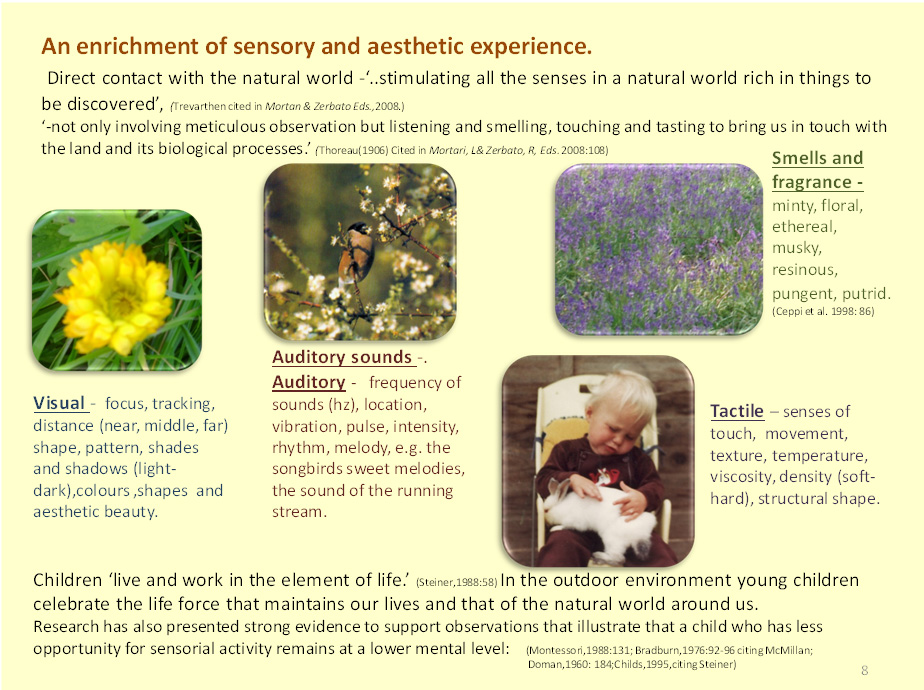 ‘A child needs to live naturally and not simply have knowledge of nature.’(Montessori,1967:67,172)(Montessori,1988:200)
In the Norwegian nurseries the ‘children experience wooded areas with rivers and streams every day’(Curruthers cited in Moyles,2007:176)Lasenby describes weather as ‘one of the most valuable resources’ which provides experiential experience that increases children’s ‘knowledge and understanding of the world in which they live.’ (Cited in Ouvry,2003:24)In Finland the outdoor Forest School approach presents the wild natural environment and the changing seasons as the curriculum and the teacher for children up to the age of six; Finland is regularly placed in top positions in the Organisation for Economic Cooperation and Development’s ‘prestigious world rankings for educational performance and literacy’. (Honore, 2004:25)
Forest schools present a belief in ‘the holistic benefit of natural experiences’ and consider the natural environment as ‘awe-inspiring’ for young children. (Moyles,2007:177)The Danish Early Years curriculum describes the Natural outdoor Forest School environments successfully meet the following six areas of learning required ‘to create a competent child’:-
‘A child needs to live naturally and not simply have knowledge of nature.’(Montessori,1967:67,172)(Montessori,1988:200)
In the Norwegian nurseries the ‘children experience wooded areas with rivers and streams every day’(Curruthers cited in Moyles,2007:176)Lasenby describes weather as ‘one of the most valuable resources’ which provides experiential experience that increases children’s ‘knowledge and understanding of the world in which they live.’ (Cited in Ouvry,2003:24)In Finland the outdoor Forest School approach presents the wild natural environment and the changing seasons as the curriculum and the teacher for children up to the age of six; Finland is regularly placed in top positions in the Organisation for Economic Cooperation and Development’s ‘prestigious world rankings for educational performance and literacy’. (Honore, 2004:25)
Forest schools present a belief in ‘the holistic benefit of natural experiences’ and consider the natural environment as ‘awe-inspiring’ for young children. (Moyles,2007:177)The Danish Early Years curriculum describes the Natural outdoor Forest School environments successfully meet the following six areas of learning required ‘to create a competent child’:-
- Language,
- All round Personal development,
- Body and movement,
- Nature and natural phenomena,
- Cultural expression and values,
- Social development. (Austin,2007:64;)

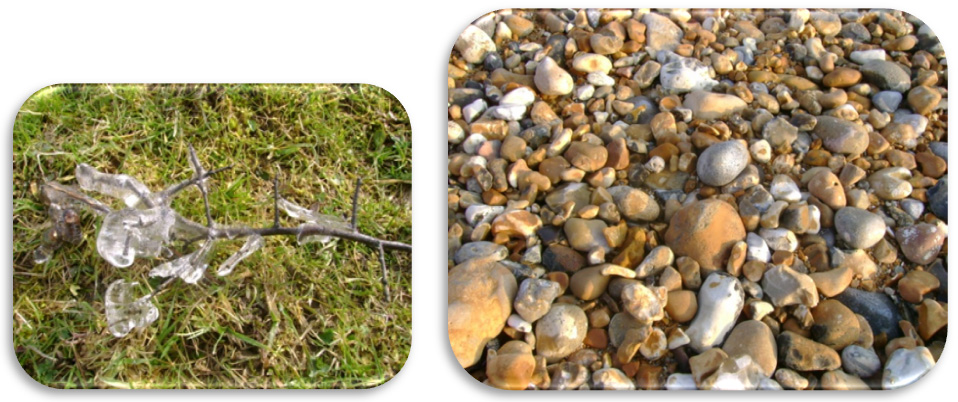
 Visual Perceptual Skills
Visual perceptual skills are strongly motivated within the world of nature especially in relation to animals where detailed visual discriminationincludes the skills of visual tracking and visual closure.
Visual Perceptual Skills
Visual perceptual skills are strongly motivated within the world of nature especially in relation to animals where detailed visual discriminationincludes the skills of visual tracking and visual closure.
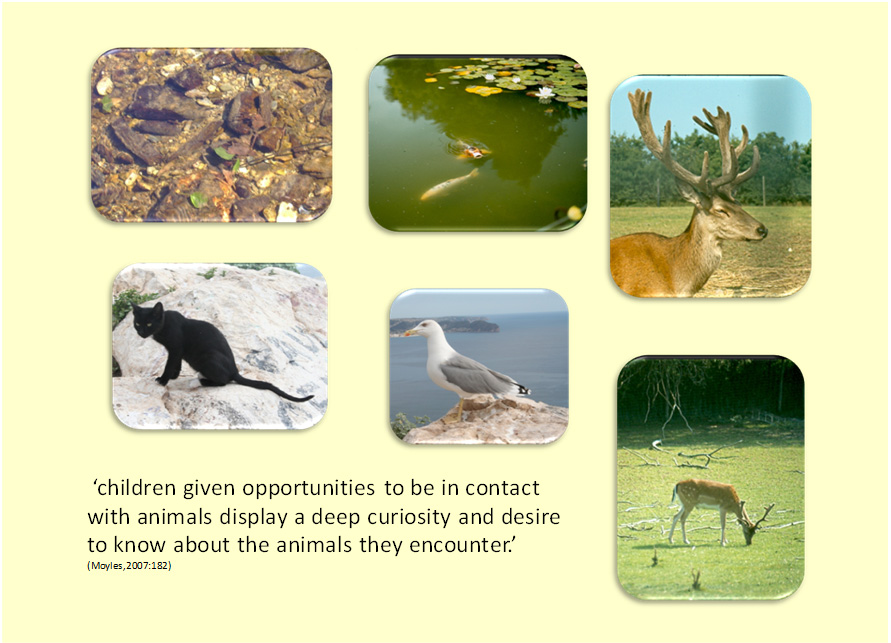 Freedom to Move
Outdoor spaces offer more physical space which supports greater freedoms of physical activity and therefore accidents may be less frequent and less serious than those encountered in the more crowded and intense indoor environments......
Freedom to Move
Outdoor spaces offer more physical space which supports greater freedoms of physical activity and therefore accidents may be less frequent and less serious than those encountered in the more crowded and intense indoor environments......
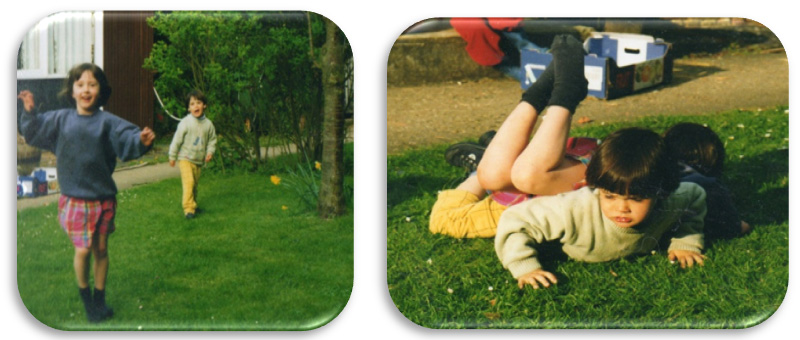 The children learn to take responsibility for their own awareness of what they can do safely. The natural outdoor environment addresses the output and impute of sensory information from all the major sensory modalities and ‘leads to the recognition that the entire brain is involved in movement.’ (Callaway,2005:10)
Issues related to children’s safety are integral to their ability to judge what level of activity can be accommodated safely on a moment by moment basis. The skills associated with safety are also interconnected with other areas of development such as those listed below:-
The children learn to take responsibility for their own awareness of what they can do safely. The natural outdoor environment addresses the output and impute of sensory information from all the major sensory modalities and ‘leads to the recognition that the entire brain is involved in movement.’ (Callaway,2005:10)
Issues related to children’s safety are integral to their ability to judge what level of activity can be accommodated safely on a moment by moment basis. The skills associated with safety are also interconnected with other areas of development such as those listed below:-
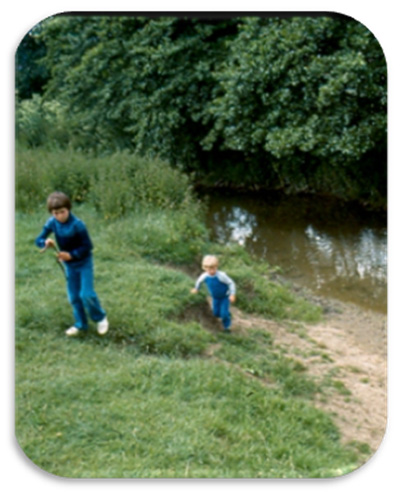
- Secure balance is inseparable from the development of postural control, which in turn is supported by information from: visual, proprioception, and motor systems.’
- Physical movement and the development of visual eye movements and associated visual perceptual competence are interdependent.
- The academic foundations of numeracy, reading and writing are initially dependent upon the ability to know one’s ‘position in space’ and associated directional awareness.
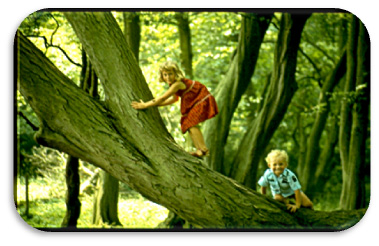 The skills of balance, mobility and co-ordination associated with physical movement have been shown to improve children’s ability to negotiate challenges and explore related aspects of ability and safety.Natural environments can offer a wide choice of activity to suit different levels of confidence, adventure and physical ability.(Callaway,2005:10)
The skills of balance, mobility and co-ordination associated with physical movement have been shown to improve children’s ability to negotiate challenges and explore related aspects of ability and safety.Natural environments can offer a wide choice of activity to suit different levels of confidence, adventure and physical ability.(Callaway,2005:10)
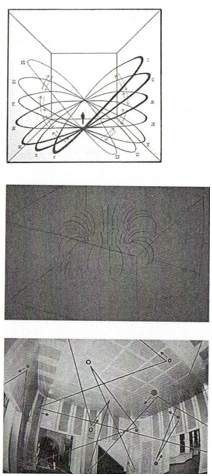 ‘Education cannot be effective unless it helps the child to open himself to life.........it is essential that a child’s spontaneous movements should not be checked or that he be compelled to act according to the will of another.’ (Montessori,1967:50)
Vestibular stimulation also influences specific physiological and biochemical changes in the body associated with emotional experiences.
‘Immature vestibular functioning is frequently found amongst children who have specific learning difficulties and adults who suffer from anxiety and Agoraphobia and panic disorders.’ (Goddard,2004:17)
‘Nature deficit disorder ...... diminished used of the senses, attentiondifficulties and higher rates of physical and emotional illness.’ New studies suggest that the exposure to nature may reduce the symptoms of attention deficit hyperactivity disorder and that it can improve all children's cognitive abilities and resistance to negative stresses and depression.’ (Louv,2006:34)
In contrast to the wealth of experiential sensory experiences presented in natural environments some aspects of indoor learning environments are thought to disrupt the child’s sensory development e.g. manmade structures, buildings and machinery are thought to disturb the young child’s developing auditory perception and integration of sounds.
At birth the human ear has the potential to detect frequencies from16hz low sounds up to 25000hzhigh sounds. Low frequencies sounds below 100hz are often felt as vibrations through the skin rather than heard.’ and most adults have lost the range of hearing they were born with only retaining accurate hearing within the range of their spoken language of approximately 125-8000hz. The work of Johansen, using frequency specific music for improving hearing discrimination and speed and integration of auditory processing, has successfully helped children with learning difficulties such as dyslexia. In order to locate the source of sound the brain interprets the small differences in time and intensity between how and when a sound is received in the two ears.
‘Nature finds expression through music- From the whispering of the wind in the leaves, to the thundering of a stormy sea on the shore. Just as all living things share the characteristic of motion, all of life is sound....’(Goddard, 2004:69,73,79,91)
The work of Rauscher & Shaw (1996) showed a clear ‘link between music, and Spatial intelligence – the accurate perceptual ability and mental imagery in pre-school children. (Cited in Goddard,2004:79)
Within any building sounds are distorted by reverberation and absorption as illustrated in these diagrams.
Some buildings also have special insulation to keep out external sounds. Within the indoor classroom background noise and auditory language is likely to dominate the acoustic geography and may deter the children from retaining and developing focused listening skills. These factors also add complex auditory deviations and variables of intensity to the young child’s task of developing accurate auditory perceptual skills and may contribute to why children prefer to play outside where the acoustics are more stable.
‘Education cannot be effective unless it helps the child to open himself to life.........it is essential that a child’s spontaneous movements should not be checked or that he be compelled to act according to the will of another.’ (Montessori,1967:50)
Vestibular stimulation also influences specific physiological and biochemical changes in the body associated with emotional experiences.
‘Immature vestibular functioning is frequently found amongst children who have specific learning difficulties and adults who suffer from anxiety and Agoraphobia and panic disorders.’ (Goddard,2004:17)
‘Nature deficit disorder ...... diminished used of the senses, attentiondifficulties and higher rates of physical and emotional illness.’ New studies suggest that the exposure to nature may reduce the symptoms of attention deficit hyperactivity disorder and that it can improve all children's cognitive abilities and resistance to negative stresses and depression.’ (Louv,2006:34)
In contrast to the wealth of experiential sensory experiences presented in natural environments some aspects of indoor learning environments are thought to disrupt the child’s sensory development e.g. manmade structures, buildings and machinery are thought to disturb the young child’s developing auditory perception and integration of sounds.
At birth the human ear has the potential to detect frequencies from16hz low sounds up to 25000hzhigh sounds. Low frequencies sounds below 100hz are often felt as vibrations through the skin rather than heard.’ and most adults have lost the range of hearing they were born with only retaining accurate hearing within the range of their spoken language of approximately 125-8000hz. The work of Johansen, using frequency specific music for improving hearing discrimination and speed and integration of auditory processing, has successfully helped children with learning difficulties such as dyslexia. In order to locate the source of sound the brain interprets the small differences in time and intensity between how and when a sound is received in the two ears.
‘Nature finds expression through music- From the whispering of the wind in the leaves, to the thundering of a stormy sea on the shore. Just as all living things share the characteristic of motion, all of life is sound....’(Goddard, 2004:69,73,79,91)
The work of Rauscher & Shaw (1996) showed a clear ‘link between music, and Spatial intelligence – the accurate perceptual ability and mental imagery in pre-school children. (Cited in Goddard,2004:79)
Within any building sounds are distorted by reverberation and absorption as illustrated in these diagrams.
Some buildings also have special insulation to keep out external sounds. Within the indoor classroom background noise and auditory language is likely to dominate the acoustic geography and may deter the children from retaining and developing focused listening skills. These factors also add complex auditory deviations and variables of intensity to the young child’s task of developing accurate auditory perceptual skills and may contribute to why children prefer to play outside where the acoustics are more stable.
 Questions to consider :-
Questions to consider :-
- At what point does auditory sound become ‘obnoxious sensory stimulation...perceived as noise’ ? (Taylor p112 )
- What influence might this have on the young child’s auditory range of perception and development of discrimination?
- What auditory range might we suppose is perceived by children who have grown up in natural outdoor environments, living within nature’s sounds and silences?
 A growing body of evidence indicates that direct exposure to nature is essential for physical and emotional health. ‘Nature deficit disorder ...... diminished used of the senses, of attention difficulties and higher rates of physical and emotional illness.’
A growing body of evidence indicates that direct exposure to nature is essential for physical and emotional health. ‘Nature deficit disorder ...... diminished used of the senses, of attention difficulties and higher rates of physical and emotional illness.’
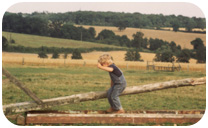 New studies suggest that the exposure to nature may reduce the symptoms of attention deficit hyperactivity disorder and that it can improve all children's cognitive abilities and resistance to negative stresses and depression.’ (Louv,2006:34)
‘Presently the Early Years Foundation Stage (DfES 2006) is promoting and focusing on teachers’ awareness of engaging boys. More access and opportunity to go outside and connect with larger spaces that can accommodate boys’ interests’ and ‘provide a more boy-friendly environment.’(Moyles, Ed. 2007:182)
New studies suggest that the exposure to nature may reduce the symptoms of attention deficit hyperactivity disorder and that it can improve all children's cognitive abilities and resistance to negative stresses and depression.’ (Louv,2006:34)
‘Presently the Early Years Foundation Stage (DfES 2006) is promoting and focusing on teachers’ awareness of engaging boys. More access and opportunity to go outside and connect with larger spaces that can accommodate boys’ interests’ and ‘provide a more boy-friendly environment.’(Moyles, Ed. 2007:182) 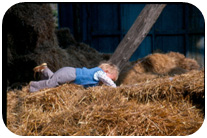 The natural world bountifully nurtures all aspects of movement and sensory experience within an essentially social and spiritual constitution that gives a depth and wealth of support to early development within the sensitive periods. (Montessori,1988:201; Montessori,1967:172; Meadows,2006:336)
The natural world bountifully nurtures all aspects of movement and sensory experience within an essentially social and spiritual constitution that gives a depth and wealth of support to early development within the sensitive periods. (Montessori,1988:201; Montessori,1967:172; Meadows,2006:336)
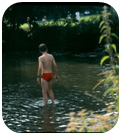 The pictures below illustrate an example of the different sensory experience and interaction presented to a child’s feet within the contrasting indoor and outdoor play experiences.
(Myriad; Catalogue 12, 2009: 11, 68, 15&22 )
The pictures below illustrate an example of the different sensory experience and interaction presented to a child’s feet within the contrasting indoor and outdoor play experiences.
(Myriad; Catalogue 12, 2009: 11, 68, 15&22 )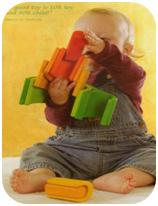 The natural elements of the outdoor environment can take wellbeing beyond that of thinking, feeling and doing to one of appreciation, gratitude, celebration and loving care. Thus, the seeds of intellectual and spiritual enquiry are sewn together with perceptual depths and physical ability; a holistic approach to learning. This builds cognitive intellectual development and initiates aesthetic and inventive application to creative activity – whereby, a state of wellbeing and joyful happiness can be maintained.
The natural elements of the outdoor environment can take wellbeing beyond that of thinking, feeling and doing to one of appreciation, gratitude, celebration and loving care. Thus, the seeds of intellectual and spiritual enquiry are sewn together with perceptual depths and physical ability; a holistic approach to learning. This builds cognitive intellectual development and initiates aesthetic and inventive application to creative activity – whereby, a state of wellbeing and joyful happiness can be maintained.
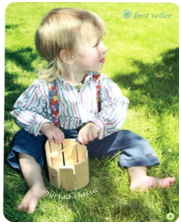 ‘Research....suggests that children seem to have a special affinity, or connection to the natural world – that they experience a kind of ‘primal seeing’ which allow them to ‘ experience the natural world in a deep and direct manner, not as a background for events, but rather, as a factor and stimulation.’ (Sebba cited in MacMillan,2008:10)
‘For everything going on in nature is permeated by a hidden music, the earthly projection of the “music of the spheres.” Every plant, every animal actually incorporates the tones of the music of the spheres.’ (Steiner,1982:19)
In Scandinavia Nature provides the Kindergartens with the educational environment and curriculum of activity, the adults have responsibility for maintaining that the children are well nourished with suitable provisions for rest/sleeping and are appropriately dressed in all weathers. Adults are also available to respond to children’s communications, interests and requests for companionship, supportive scaffolding, and play-partnerships. The adult also has a passively receptive role - quiet, attentive and observant, and generally refrains from actively presenting encouragement, suggestion, praise or directives. If a child is busily engaged s/he is ‘left undisturbed for as long as possible’. During a child’s discovery process the adult does not present any ‘unnecessary talk’, interfere with the child’s concentration or disrupt ‘natural situations for peer scaffolding for learning concrete skills.’ (Einarsdottir&Wagner,2006:208) Harrison, (2002:13)suggests that when children are free to explore they can ‘discover their passions - the activities, the skills that bring forth the totality of their Life Energy’. They can come to ‘understand the nature of a joyful life’ where, success and failure are intrinsic within the creativity of observation and doing; free from contrived external rewards or reprimands, manmade structures, preconceived styles of learning, restrictive boundaries, predetermined social rules and external expectations.
‘Research....suggests that children seem to have a special affinity, or connection to the natural world – that they experience a kind of ‘primal seeing’ which allow them to ‘ experience the natural world in a deep and direct manner, not as a background for events, but rather, as a factor and stimulation.’ (Sebba cited in MacMillan,2008:10)
‘For everything going on in nature is permeated by a hidden music, the earthly projection of the “music of the spheres.” Every plant, every animal actually incorporates the tones of the music of the spheres.’ (Steiner,1982:19)
In Scandinavia Nature provides the Kindergartens with the educational environment and curriculum of activity, the adults have responsibility for maintaining that the children are well nourished with suitable provisions for rest/sleeping and are appropriately dressed in all weathers. Adults are also available to respond to children’s communications, interests and requests for companionship, supportive scaffolding, and play-partnerships. The adult also has a passively receptive role - quiet, attentive and observant, and generally refrains from actively presenting encouragement, suggestion, praise or directives. If a child is busily engaged s/he is ‘left undisturbed for as long as possible’. During a child’s discovery process the adult does not present any ‘unnecessary talk’, interfere with the child’s concentration or disrupt ‘natural situations for peer scaffolding for learning concrete skills.’ (Einarsdottir&Wagner,2006:208) Harrison, (2002:13)suggests that when children are free to explore they can ‘discover their passions - the activities, the skills that bring forth the totality of their Life Energy’. They can come to ‘understand the nature of a joyful life’ where, success and failure are intrinsic within the creativity of observation and doing; free from contrived external rewards or reprimands, manmade structures, preconceived styles of learning, restrictive boundaries, predetermined social rules and external expectations.
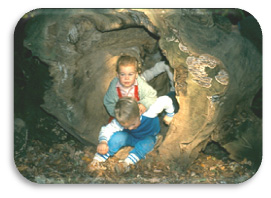 The natural world as curriculum and teacher bountifully nurtures all aspects of movement and sensory experience within an essentially social and spiritual constitution that gives a depth and wealth of support to early development within the sensitive periods. The natural elements of the outdoor environment can take wellbeing beyond that of thinking, feeling and doing to one of appreciation, gratitude, celebration and loving care. Thus, the seeds of spiritual enquiry are sewn together with perceptual depths. This builds cognitive intellectual development and initiates aesthetic and inventive application to creative activity.
The natural environment provides a treasure basket of natural materials for heuristic play (Goldschmied, 2004),as well as a wealth of aesthetic experiences. Motivation for movement is related to interest, needs and abilities provided by interactive experiences with natural phenomena which encourage good foundations for physical development, health and fitness.Human biology illustrates that there is a direct relationship between exercise, physical growth, breathing rate, lung capacity, neurological brain development, emotional stability and intellectual development.(Vander et al. 2001)Doman’s research illustrated that functional activity determines structural development in the brain as well as in the body. (Doman,1960:189&262)Steiner presents that Sensory-motor activity (movement) ‘also equates with the consequential development of language and thinking.’ (Steiner, 1988:32)
The natural world as curriculum and teacher bountifully nurtures all aspects of movement and sensory experience within an essentially social and spiritual constitution that gives a depth and wealth of support to early development within the sensitive periods. The natural elements of the outdoor environment can take wellbeing beyond that of thinking, feeling and doing to one of appreciation, gratitude, celebration and loving care. Thus, the seeds of spiritual enquiry are sewn together with perceptual depths. This builds cognitive intellectual development and initiates aesthetic and inventive application to creative activity.
The natural environment provides a treasure basket of natural materials for heuristic play (Goldschmied, 2004),as well as a wealth of aesthetic experiences. Motivation for movement is related to interest, needs and abilities provided by interactive experiences with natural phenomena which encourage good foundations for physical development, health and fitness.Human biology illustrates that there is a direct relationship between exercise, physical growth, breathing rate, lung capacity, neurological brain development, emotional stability and intellectual development.(Vander et al. 2001)Doman’s research illustrated that functional activity determines structural development in the brain as well as in the body. (Doman,1960:189&262)Steiner presents that Sensory-motor activity (movement) ‘also equates with the consequential development of language and thinking.’ (Steiner, 1988:32)
 ‘... humanity, which is revealed in all its intellectual splendour during the sweet and tender age of childhood ....... is like a sun which appears at dawn or a flower just beginning to bloom. Education cannot be effective unless it helps the child to open himself to life.’ (Montessori,1967:50)
In the outdoor environment young children celebrate the life force that maintains our lives and that of the natural world around us. When we the educators have the privilege of observing how, children celebrate their love of life in natural outdoor environments and dance in a joyful mood or, on occasions in a festive way that lasts for two or three consecutive days; then we are honoured with a spiritual initiation that can bring us to share the children’s effulgent state of being and know a potential beyond that of happiness and enthusiasm – when the God we seek is found within our state of wellbeing and joyful inner harmony.
When in a natural outdoor environment spiritual aspirations are initiated by natural phenomena. For example the author recalls a truly unforgettable experience of beauty and stillness, that invoked a quietening of the mind normally associated with contemplation and states of meditation: It happened while on a winter forest walk with a group of young children, along a sheltered track that followed a small valley and stopped at a favourite place by the stream. It was quiet and the children were relaxed and happy to just be there by the stream peacefully. Then a deeper sense of stillness came over the area, like an invisible blanket it created a silence beyond that of the stillness, it felt as if nature herself had stopped breathing. My feelings drifted from a divine kind of inner peace into occasional momentary feelings of protective concern. Before I could decide upon any leadership action the snow clouds could be seen creeping towards us bringing a snowflake waterfall that appeared advancing against the strong flow of the stream, silently it filled the valley with a rapidly growing depth of pure whiteness.
In nature children can find extensive challenges at all levels of relationship and personal ability that gently encourage them to go a little further than before.....If we use the unlimited natural resources of our universe to support children’s development of awareness, and their speed and parameters of thought, then the potential of the future can extend beyond what humanity has attained to date.
In Honour of the Trees
Standing tall in your strength against time.
In silent unseeing observation,
‘... humanity, which is revealed in all its intellectual splendour during the sweet and tender age of childhood ....... is like a sun which appears at dawn or a flower just beginning to bloom. Education cannot be effective unless it helps the child to open himself to life.’ (Montessori,1967:50)
In the outdoor environment young children celebrate the life force that maintains our lives and that of the natural world around us. When we the educators have the privilege of observing how, children celebrate their love of life in natural outdoor environments and dance in a joyful mood or, on occasions in a festive way that lasts for two or three consecutive days; then we are honoured with a spiritual initiation that can bring us to share the children’s effulgent state of being and know a potential beyond that of happiness and enthusiasm – when the God we seek is found within our state of wellbeing and joyful inner harmony.
When in a natural outdoor environment spiritual aspirations are initiated by natural phenomena. For example the author recalls a truly unforgettable experience of beauty and stillness, that invoked a quietening of the mind normally associated with contemplation and states of meditation: It happened while on a winter forest walk with a group of young children, along a sheltered track that followed a small valley and stopped at a favourite place by the stream. It was quiet and the children were relaxed and happy to just be there by the stream peacefully. Then a deeper sense of stillness came over the area, like an invisible blanket it created a silence beyond that of the stillness, it felt as if nature herself had stopped breathing. My feelings drifted from a divine kind of inner peace into occasional momentary feelings of protective concern. Before I could decide upon any leadership action the snow clouds could be seen creeping towards us bringing a snowflake waterfall that appeared advancing against the strong flow of the stream, silently it filled the valley with a rapidly growing depth of pure whiteness.
In nature children can find extensive challenges at all levels of relationship and personal ability that gently encourage them to go a little further than before.....If we use the unlimited natural resources of our universe to support children’s development of awareness, and their speed and parameters of thought, then the potential of the future can extend beyond what humanity has attained to date.
In Honour of the Trees
Standing tall in your strength against time.
In silent unseeing observation, Of generations growing from child into parenting.
While the wind brings an ever moving creativity to your serenity,
Your roots remain secure in the abundance of a future potency,
You greet the ways of our days
But we rarely appreciate the longevity of your life giving presence.
Those unconditional fortunes given to a world of little gratitude and faint observations.
What have you seen that we still don’t understand?
What have we done to the natural lands?
Yet still the sun, the moon and the stars
Shine their blessings upon thee
As your leaves float on down the stream
Winter flows under your boughs once again.
As my life weakens with old age
Yours grows with everlasting maturity
Our reunion builds a rainbow across my lifetime,
As again I feel your companionship to my childhood.
‘Free Play’as a Foundation for Learning
Some Early Year’s education theorists and psychologists have presented the importance of free play activity as a prerequisite foundation for learning (Einarsdottir&Wagner,2006:208) The work of Macmillan (Bradburn,1976:57-58), Montessori(1967:173), Steiner(1981:51-54)and Goldschmied(Goldschmied&Jackson,2004:97-99) suggest young children are spontaneous observers of nature and can gain a wealth of perceptual skills and detailed awareness of discrimination and differentiation (Montessori,1967:70-71.) long before this information is consciously structured, categorised, calculated or manipulated as an academic understanding through formal thinking operations. The freedom to play and explore the abundance of materials and possible activities given by a natural outdoor environment can encourage and support the unlimited aspects of human potential - ‘physical performance’ related to ‘physical intelligence’, the mastery of integrating thoughts with actions.
‘Essential changes take place in the development of a child’s motivation under the influence of play.’ (Einarsdottir&Wagner,2006:214citingEl’konin (1978/1999))
Play seems to embrace a purity of thought that perceives truth without educational interference and thereby initiates the powers of thought within a cycle of dream-thought- action and the development of talent.
‘...even a small child should not be distracted from what he’s doing in other words the operation of his thought should not be stopped......education ...begins with the correct presentation of questions whereby children are encouraged to think for themselves and make their own independent decisions. ’ (Megre Book7;49)
Pioneering educators that advocate the young child’s affinity with the naturalecology, considered the natural environment a stimulating and nurturing resource for all aspects of the young child’s physical, mental, emotional and spiritual development.
Exploration and Discovery Learning
‘Children if left to explore can discover their passions - the activities, the skills that bring forth the totality of their Life Energy’. They can come to ‘understand the nature of a joyful life’ where, success and failure are intrinsic within the creativity of observation and doing; free from man-made rewards and punishment, structural boundaries and associated dangers, social rules and expectations. (Harrison,2002:13) In nature children are finding out about the world for themselves, and about themselves as a part of the living world.
Research has suggested that adults are more willing to let children:-
Of generations growing from child into parenting.
While the wind brings an ever moving creativity to your serenity,
Your roots remain secure in the abundance of a future potency,
You greet the ways of our days
But we rarely appreciate the longevity of your life giving presence.
Those unconditional fortunes given to a world of little gratitude and faint observations.
What have you seen that we still don’t understand?
What have we done to the natural lands?
Yet still the sun, the moon and the stars
Shine their blessings upon thee
As your leaves float on down the stream
Winter flows under your boughs once again.
As my life weakens with old age
Yours grows with everlasting maturity
Our reunion builds a rainbow across my lifetime,
As again I feel your companionship to my childhood.
‘Free Play’as a Foundation for Learning
Some Early Year’s education theorists and psychologists have presented the importance of free play activity as a prerequisite foundation for learning (Einarsdottir&Wagner,2006:208) The work of Macmillan (Bradburn,1976:57-58), Montessori(1967:173), Steiner(1981:51-54)and Goldschmied(Goldschmied&Jackson,2004:97-99) suggest young children are spontaneous observers of nature and can gain a wealth of perceptual skills and detailed awareness of discrimination and differentiation (Montessori,1967:70-71.) long before this information is consciously structured, categorised, calculated or manipulated as an academic understanding through formal thinking operations. The freedom to play and explore the abundance of materials and possible activities given by a natural outdoor environment can encourage and support the unlimited aspects of human potential - ‘physical performance’ related to ‘physical intelligence’, the mastery of integrating thoughts with actions.
‘Essential changes take place in the development of a child’s motivation under the influence of play.’ (Einarsdottir&Wagner,2006:214citingEl’konin (1978/1999))
Play seems to embrace a purity of thought that perceives truth without educational interference and thereby initiates the powers of thought within a cycle of dream-thought- action and the development of talent.
‘...even a small child should not be distracted from what he’s doing in other words the operation of his thought should not be stopped......education ...begins with the correct presentation of questions whereby children are encouraged to think for themselves and make their own independent decisions. ’ (Megre Book7;49)
Pioneering educators that advocate the young child’s affinity with the naturalecology, considered the natural environment a stimulating and nurturing resource for all aspects of the young child’s physical, mental, emotional and spiritual development.
Exploration and Discovery Learning
‘Children if left to explore can discover their passions - the activities, the skills that bring forth the totality of their Life Energy’. They can come to ‘understand the nature of a joyful life’ where, success and failure are intrinsic within the creativity of observation and doing; free from man-made rewards and punishment, structural boundaries and associated dangers, social rules and expectations. (Harrison,2002:13) In nature children are finding out about the world for themselves, and about themselves as a part of the living world.
Research has suggested that adults are more willing to let children:-
- direct their own play activities,
- organise and change the physical aspects of the environment,
- integrate themselves socially into their own co-operative games,
- settle their own disputes and issues of conflict, and children are more able to:-
- request help from adults and peers,
- play cooperatively together in mixed age groups,
- play cooperatively with children from different backgrounds and/or learning disabilities.
 Children can make choices of what, when and how to share with adults and vice versa.
Adults can relax into a more compassionate and attentive role as listener and share in child initiated conversations and activities.
Early creativity and experimentation can provide foundations for future ‘formal operations’ and skills of creative performance
Early creativity and experimentation can provide foundations for future ‘formal operations’ and skills of creative performance
Children enjoy the challenges of working outside with the adults especially when it involves caring for
Children can make choices of what, when and how to share with adults and vice versa.
Adults can relax into a more compassionate and attentive role as listener and share in child initiated conversations and activities.
Early creativity and experimentation can provide foundations for future ‘formal operations’ and skills of creative performance
Early creativity and experimentation can provide foundations for future ‘formal operations’ and skills of creative performance
Children enjoy the challenges of working outside with the adults especially when it involves caring for animals, use of tools and physical challenges.
Children enjoy time to do their own thing in their own way, un-witnessedfree from distractions and other’s influences.
animals, use of tools and physical challenges.
Children enjoy time to do their own thing in their own way, un-witnessedfree from distractions and other’s influences.
 ‘Respectful close observation and passive participation can be effective ways of hearing young children’s powerful communications and taking account of their perspectives...’ (Peter Elfer (2005) Cited in Moyles, 2007:189.) From this perspective adults can successfully scaffold learning with careful adult organisation, specialist supervision and safety equipment.
Adults can structure special activities to suit individual children’s interests and encourage working together and sharing social events as a community
‘Respectful close observation and passive participation can be effective ways of hearing young children’s powerful communications and taking account of their perspectives...’ (Peter Elfer (2005) Cited in Moyles, 2007:189.) From this perspective adults can successfully scaffold learning with careful adult organisation, specialist supervision and safety equipment.
Adults can structure special activities to suit individual children’s interests and encourage working together and sharing social events as a community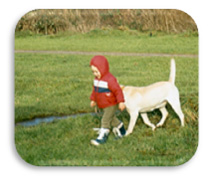 During their early years children may gain an affinity, detailed perceptual skills, and a respectful sense of curiosity and enquiry that can have a positive influence upon their growing intellectual abilities. Steinerdescribes the young child’s affinity to the nature world as ‘a deep,
During their early years children may gain an affinity, detailed perceptual skills, and a respectful sense of curiosity and enquiry that can have a positive influence upon their growing intellectual abilities. Steinerdescribes the young child’s affinity to the nature world as ‘a deep, 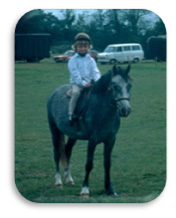 inner feeling that the plant world belongs to the Earth’ and an inner awareness of ‘the true relationship between the human and the animal world...’(Steiner,1997:68) In nature we see skills and abilities that are equal to and beyond normal human abilities.
inner feeling that the plant world belongs to the Earth’ and an inner awareness of ‘the true relationship between the human and the animal world...’(Steiner,1997:68) In nature we see skills and abilities that are equal to and beyond normal human abilities.
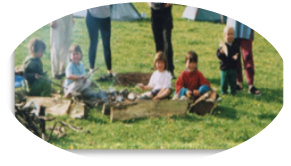 12 Points for Good Listening.
12 Points for Good Listening.
Based on the work and teaching of the late Rachael Pinney who pioneered work on Creative Listening and Special Time.
1. If you want to listen to a child or you want a child to listen to you firstly make sure you are at the same eye level as the child so that natural eye contact can be established. This also avoids an intimidating standing over position may disturb the child's confidence and thereby create a non communicative disposition.
2. Be honest about your ability to listen properly. ‘I'm sorry I can't listen properly right now I will come and listen to you as soon as I can.’
3. When offering a listening space try to be still, make gentle, avoid intrusive eye contact and embrace an authentic commitment of time, body and feelings.
4. When a child presents auditory communication Pause and take time to evaluate the degree of listening required for the response that is needed. Sometimes a momentary mmmmmm.or aha or the single word response is sufficient.
5. Sometimes a moment of eye contact for a brief moment of caring physical contact is more important than verbal responses and reassurance.
6. Reflect back to the child what you think they have said. This gives the child the opportunity to be confidently interpret what you have heard, qualify any misunderstandings. This reflective response to listening also gives the child time to consider what he had said from his own perspective of personal reasons, requests and responses.
7. Reflector and recap in a non judgmental way when one or more children have come to present their own views on a disagreement.
8. Never underestimate the depth of the child's feelings or the amount of courage and effort associated with their communications. When this dialogue of Reflective Listening is successfully presented inevitably the children solve the problems themselves. reflection gives children time to assess their situation and their feelings more clearly.
9. Listening is hard work they in question how you are feeling yourself and what uncomfortable issues the Childs communication is bringing are within yourself at that time.
10. Similarly adults can reflect on their own behaviour and apologise when their own emotional issues have dominated communication and listening skills.
11. In situations where the adult cannot allow the child to do what he wants to do, firm boundaries can be presented from a compassionate place of listening and communication. For example the adult can simply say I'm sorry I can't let you do that.’ This illustrates that the adult has thought about what the child wants to do and having acknowledged the child's wishes communicates the adult perspective as regrettable but necessary. Hasty and/or intense attempts to control the child's behaviour are seen by the child has a lack of understanding the consideration for the child's level of desire, and the child becomes frustrated because he believes he has not been heard. It is important the adults communicate at the child that his desires are not able to be accommodated in the present situation.
12. Negative and disruptive feelings' within the adult when they are more frightening for the child when they are not openly acknowledged, than when they are openly communicated.
For example I feel very angry that you scribbled on your bedroom wall or I feel very angry that you did not listen when I told you not to do it. These honest comments can helps the child realise that your anger is to do with their own or another person's behaviour rather than rather than their personal existence, they themselves.
A topic and project approach to child-directed learning was pioneered by the Villagers of Reggio Emilia in 1946 for their pre-school children.
 The Reggio Preschool Pedagogy wasdesigned to restore the young children’s rights to choose for themselves and joyfully retain:-
Their personal liberty, A love of learning & enthusiasm to participate with passionate creativity.
The Reggio Preschool Pedagogy wasdesigned to restore the young children’s rights to choose for themselves and joyfully retain:-
Their personal liberty, A love of learning & enthusiasm to participate with passionate creativity.
Contents
Introduction to The Reggio Preschool Pedagogy
A ‘creative and reflective pedagogy’ (Bancroft,2007:5)
oflistening and relationships. (Abbot,Nutbrown,2001:128)
Reggio theory in practice
Examples of Working Practice:-
- A Child Initiated Emergent Curriculum
- ‘Giovanni’s 3-dimentional construction ‘The Mountains of Past and Future’
Using Various Media Resources
Reggio Pedagogy
Qualities Associated with Creative Learning
The Reggio Pedagogy Integrates Previous Educational Theories
A Yin and Yang perspective
Adults share their personal knowledge and experience through their wider access to resources,
Inappropriate adult input can be ignored:-
Extending investigation into the community.
Integrating II and III dimensional representation
Engaging in an emergent curriculum of creative activity.
Celebrating Change
Motivation
Thinking Processes
Qualities associated with the Human Potential
Conclusion
Steiner, Montessori and Piaget
Early year’s development
The essence of Reggio approach summarised by the author
Conclusion
Introduction to The Reggio Preschool Pedagogy
| In 1946, after Nazi occupation of their home land, the villagers of Villa Cella, Reggio, Italy, sought to create a culturally progressive experience for their new generation of young children. The cooperative efforts of the working community; the farmer’s, the day labourers, the factory workers built and funded a specially designed nursery school for their children. (Opened January 13th, 1947 with 30 pupils, a teacher and a cook). ‘In every brick of “the people’s preschool” there was trust, awareness, willingness, and hope.’ (Barazzoni,2000:29) which inspired:- Socialised Management, Democracy, Young children as Liberated Citizens. This ‘profound illustration of humanity’ founded ‘a culture and professionality’ (Barazzoni,2000:28) based on ‘the richness and concreteness’ (Reggio Children,2000:9) of children’s ‘ideas, theories, questions and opinions’. (Katz,Cesarone,1994:25) |
- employs all of his resources,
- is capable of making choices
- is responsible for his own actions,
- has a sense of solidarity,
- hasa desire to learn and participate in the learning process with extreme creativity.
- A child’s knowledge is aided, in its genesis and in its development, by interaction and social cooperation;
- Education is conceived in constructivist’s terms in that it is the child himself who is the builder and main protagonist of his life and his learning processes;
- Children are moved to an unlimited curiosity and by a greater and innate desire to know and to discover;
- This extraordinary desire to investigate reality must be made visible and helped to grow and develop without being imprisoned in reconstituted models based on programmed information;
- The most important ability for a teacher is knowing how to capture those vital and significant events as they appear, around which the teacher’s invention should be organized.
A ‘creative and reflective pedagogy’ (Bancroft,2007:5)
of listening and relationships. (Abbot,Nutbrown,2001:128)
The roles of the Reggio teachers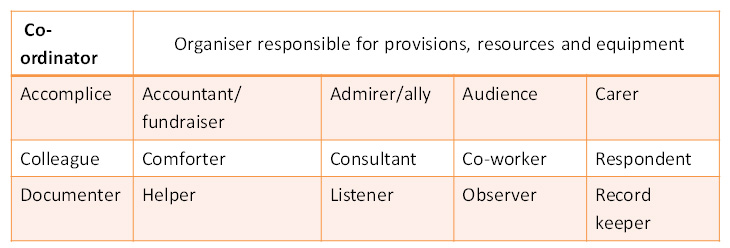 A pedagogy imbued with open-hearted authenticity ‘.......the activity of making projects conceived as functional interaction between needs, resources, conditions, knowledge and method.’ (Reggio Children 2001:56)
A pedagogy imbued with open-hearted authenticity ‘.......the activity of making projects conceived as functional interaction between needs, resources, conditions, knowledge and method.’ (Reggio Children 2001:56)
Reggio teachers feel it is important to focus on beauty, art and aesthetic value.
‘the attention to detail and beauty’ ‘foster the children’s aesthetic sense’ and illustrates ‘an “amiable” environment where relationships can flourish.’ (Frazer, Gestwiki,Ed. 2002:89)The Reggio approach
The Reggio approach appears to have an integrated focus on participation, democracy, social and environmental relationships, listening skills, child initiated learning,documentation, creativity and independence.These important issues are co-ordinated within the organisation of the physical environment and the social relationships established within the educational community –‘nurturing the pleasure of participation and valuing each person’s individuality.’(Rinaldi,2006:51)Reggio philosophy illustrates a ‘passion for a process that acknowledges our needs as individuals and as a society to engage in a cooperative learning adventure with others, both children and adults.’ (Katz,Cesarone Ed.,1994:36) ‘The layout of the buildings is designed to facilitate meetings and interaction between children, and great care is taken over areas of welcoming and departure.’ (Thornton,Brunton,2005:50) The Reggio pedagogy appears to be based upon an educational community that respects and values the ability and potential of the individual child and emphasizes that children are competent learners rather than ‘empty vessels that need to be filled with knowledge’ (Frazer, Gestwiki,Ed. 2002:78) Organisation of Community-based Environmental Foundations This philosophy is supported by the organisation of community based environmental foundations which are pictorially represented in the diagramme below. The Reggio philosophy embraces concerns that children may lose their natural ability to learn through creative activity when the adult organizes a predetermined curriculum and agenda of specified time and results. This was presented by
Malaguzziwhen he said:-
‘All that we need to knowabout children, for children, is best learned from the children themselves.’ (Cited in Bancroft,2007:8)
In Reggio adults actively engage in ‘collaboration, dialogue and observation’ (Bancroft,2007:14)which is considered fundamental because ‘when reciprocity is placed at the core of relationships’, ‘patterns of communication in the classroom’ become ‘more respectful, more equal and more interactive’ Respectful collaboration on all levels of interaction whereby leadership steps into the background and allows ‘strength, personalities and perspectives to come together, often challenging each other to create new perspectives and knowledge’, understanding and skills. (Frazer, Gestwiki,Ed.2002:78&94)‘Children are biologically predisposed to interpreting data with incredible creativity- encoding and decoding, listening, communicating and establishing relationships.’(Rinaldi,2006:116)
‘...a process that acknowledges our need as individuals and as a society to engage in a co-operative learning adventure with others, both children and adults.’ (Katz,Cesarone Ed.,1994:36)
Interactions between children and either an adult or a child who is more confident, act as scaffolding to nudge children to go beyond what they can achieve on their own.’ (Frazer, Gestwiki,Ed. 2002:66)
Maybe, it is the adults’ freedom to choose how, where, and when they engages with the children that gives the children permission (by example) to follow their own initiatives, and thereby maintain their natural disposition to meet their true potential?
‘.....they say our teacher’s are beautiful. It is true, there are a few places in the world where teachers in schools, early childhood or anywhere else, are as beautiful, as dignified, as womanly as they are here.’(Rinaldi,2006:167)
Reggio presents children as competent learners, personally responsible for their own actions and their own educational development, in charge of developing their own abilities, embracing their own goals and their own thinking within a holistic integration of information and understanding.
Reggio theory in practice – ‘Following a curriculum based on ideas and thinking rather than content led’. (100 Voices:DVD)
Freedom
Environmental influences of choice and a trusting disposition
Listening
Personal interpretation –generally ‘adults tend to overestimate the children’s academic ability and underestimate their ability to think and problem solve.’ (100 Voices DVD)
Communication
Relationship with an experience – ‘the child as a sophisticated thinker and communicator’.
Truth (100 Voices DVD)
A perspective based on inner feelings and external information.
Courage
Underlying personal confidence and enthusiasm.
Passion- That spark of interest that fuels a path of inquiry and motivates creative expression.
Curiosity - an extraordinary desire to investigate reality, to know, to discover.(Reggio Children, 2000:8)
Children are endowed with ‘genius, talent and creativity.....So to awaken his genius, you need to open his heart, remove complexes, tension and fear.’
The more traditional issues related to the teacher’s professional performance have been transformed into informal co-operative
The Reggio philosophy embraces concerns that children may lose their natural ability to learn through creative activity when the adult organizes a predetermined curriculum and agenda of specified time and results. This was presented by
Malaguzziwhen he said:-
‘All that we need to knowabout children, for children, is best learned from the children themselves.’ (Cited in Bancroft,2007:8)
In Reggio adults actively engage in ‘collaboration, dialogue and observation’ (Bancroft,2007:14)which is considered fundamental because ‘when reciprocity is placed at the core of relationships’, ‘patterns of communication in the classroom’ become ‘more respectful, more equal and more interactive’ Respectful collaboration on all levels of interaction whereby leadership steps into the background and allows ‘strength, personalities and perspectives to come together, often challenging each other to create new perspectives and knowledge’, understanding and skills. (Frazer, Gestwiki,Ed.2002:78&94)‘Children are biologically predisposed to interpreting data with incredible creativity- encoding and decoding, listening, communicating and establishing relationships.’(Rinaldi,2006:116)
‘...a process that acknowledges our need as individuals and as a society to engage in a co-operative learning adventure with others, both children and adults.’ (Katz,Cesarone Ed.,1994:36)
Interactions between children and either an adult or a child who is more confident, act as scaffolding to nudge children to go beyond what they can achieve on their own.’ (Frazer, Gestwiki,Ed. 2002:66)
Maybe, it is the adults’ freedom to choose how, where, and when they engages with the children that gives the children permission (by example) to follow their own initiatives, and thereby maintain their natural disposition to meet their true potential?
‘.....they say our teacher’s are beautiful. It is true, there are a few places in the world where teachers in schools, early childhood or anywhere else, are as beautiful, as dignified, as womanly as they are here.’(Rinaldi,2006:167)
Reggio presents children as competent learners, personally responsible for their own actions and their own educational development, in charge of developing their own abilities, embracing their own goals and their own thinking within a holistic integration of information and understanding.
Reggio theory in practice – ‘Following a curriculum based on ideas and thinking rather than content led’. (100 Voices:DVD)
Freedom
Environmental influences of choice and a trusting disposition
Listening
Personal interpretation –generally ‘adults tend to overestimate the children’s academic ability and underestimate their ability to think and problem solve.’ (100 Voices DVD)
Communication
Relationship with an experience – ‘the child as a sophisticated thinker and communicator’.
Truth (100 Voices DVD)
A perspective based on inner feelings and external information.
Courage
Underlying personal confidence and enthusiasm.
Passion- That spark of interest that fuels a path of inquiry and motivates creative expression.
Curiosity - an extraordinary desire to investigate reality, to know, to discover.(Reggio Children, 2000:8)
Children are endowed with ‘genius, talent and creativity.....So to awaken his genius, you need to open his heart, remove complexes, tension and fear.’
The more traditional issues related to the teacher’s professional performance have been transformed into informal co-operative
 How well the adult can listen to what and how the child/ren want to learn and achieve, feeling comfortable with unpredictable activity and creative styles of communication.
Successful scaffolding within the Zone of Proximal Development (Vygotsky) where the ‘emphasis is on relationship and reciprocity and the outcome emerges as it unfolds.’ (Frazer, Gestwiki,Ed. 2002:86)
How well the adult can listen to what and how the child/ren want to learn and achieve, feeling comfortable with unpredictable activity and creative styles of communication.
Successful scaffolding within the Zone of Proximal Development (Vygotsky) where the ‘emphasis is on relationship and reciprocity and the outcome emerges as it unfolds.’ (Frazer, Gestwiki,Ed. 2002:86)
 How to embrace changes and integrate personal experience with the unique specialness of child initiated learning.
Facilitating an inherently open-ended learning environment
How to embrace changes and integrate personal experience with the unique specialness of child initiated learning.
Facilitating an inherently open-ended learning environment
 An Emergent Curriculum - children working at their own natural pace developing their own style and methods for learning .
Sharing of ideas & possibilities without an attachment to a preconceived result.
Consideration of what others think - the child, the adult and the other children.
An Emergent Curriculum - children working at their own natural pace developing their own style and methods for learning .
Sharing of ideas & possibilities without an attachment to a preconceived result.
Consideration of what others think - the child, the adult and the other children.
- Sometimes the adults do not interrupt or disturb the children.‘.......two little girls spent 3 hours or so playing together with a collectionof red and pink glass objects displayed on a lighter box.‘No attempt was made to intervene and move them on to something else.’ (Abbot,Nutbrown,2001:69) A further example (cited in Lewin, Benham,2006:28) – four restless boys went into a store room area, closed the door and were busy doing their own thing unobserved/unsupported/unsupervised until one came and asked for some adult help with a tricky process of moving a complex piece of construction work on to a different table within their working area in the store room.
- The adults facilitate specially designed environmental support. When the children wanted to make their paper-mache mountain into a volcano the assisting adults helped the children investigatethings that would safely explode in the classroom such as popcorn and baking powder and lemon juice(Frazer, Gestwiki,Ed. 2002:143&177)‘Conversely, it was accepted that children sometimes need to ‘flit’ and activities were established to enable them to do this.’ E.g. ‘..a weaving loom...... so that children could add just one row or perhaps more in passing ’ (Abbot,Nutbrown,2001:69)
- Very special worldly experience. For ExampleGoing to see alocal water tower and later the Space Needleas an extension to the children’s focus on aspects related to height:. ‘They took the elevator up and experienced real height and different perspectives.’ (Frazer, Gestwiki,Ed. 2002:204-207)
- ‘....dynamic interaction of adults and children with one another and with the environment.’ The environment ‘acts as the third teacher’. (Frazer, Gestwiki,Ed. 2002:87&99)
- The main aspect within the High/Scope pedagogy which focuses on play and learning whereby adults engage with the children’s play as shared Special Time.
- Montessori teaching methods after the age of seven present learning through child initiated topics and projects of work that encourage the children to work together.
- As presented by Steiner philosophy and practice,the children’s development and well being is nurtured through a rich sensory environment and experiential activities provided by natural materials and aesthetically pleasing surroundings.
A Child Initiated Emergent Curriculum
An ‘exploration of excellence in early childhood education.’
Adults and children working together as a team respectfully collaborating on all levels of interaction, addressing the day to day quality of the children’s lives.
(Frazer, Gestwiki,Ed. 2002:92)(Katz,Cesarone,1994:17)

Child Initiated Curriculum
The Reggio pedagogy illustrates a child initiated curriculum based on topics of interest and describes a system of shared learning that can spontaneously integrate the theoriespresented by:-- Howard Gardner as different fields of intelligence - linguistic, musical, logical (mathematical), spatial, body - kinaesthetic, & inter personal intelligence related to the 'computational power of the brain' and ‘Experiential Intelligence’ which David Perkins terms as 'changable, learnable and reflective Intelligence' (Gardner,1996:2);
- Edward De Bono as different types of thinking– theSix Thinking Hats: Red-hat Thinking: emotions, feelings, intuition; White hat -objective information; Black-Hat: caution, truth, reality; Yellow hat: optimism, feasibility benifits; Green-Hat :creative ideas, suggestions; Blue-Hat, summary, reflection.;(DeBono,2000:13-14 :1992,74-96.)
- Tony Buzan’s Mind map approach to the integration of thinking, learning and memory skills. Symbolic representation of the radiating branches of associated thoughts, integrating: knowledge and ideas, left brain thinking (lists, sequences, numbers, letters) and right brain thinking(rhythms, colours, pictures, imagination) with creative thinking and memory skills. (BuzanDVD)‘Creativity is not just the quality of thinking of each individual but is also an interactive, relational and social project.....an everyday right as a quality of life.... It requires a context that allows it to exist, be expressed, to become visible.........What we hope for is creative learning and creative teachers........ the competent and creative child exists if there is a competent and creative adult.’ (Rinaldi,2006:120)
Hoyuelos combines the above description of Reggio pedagogy with ‘....the ideological concept of a transparent school and transparent education and the aesthetic ideaof offering a relational image of childhood through uniting process with content.’ (Cited in Children in Europe2004:7)
Giovanni’s 3-dimentional construction ‘The Mountains of Past and Future’
‘The 100 languages of children’ help children communicate creative thinking skills that are beyond their level of verbal communication.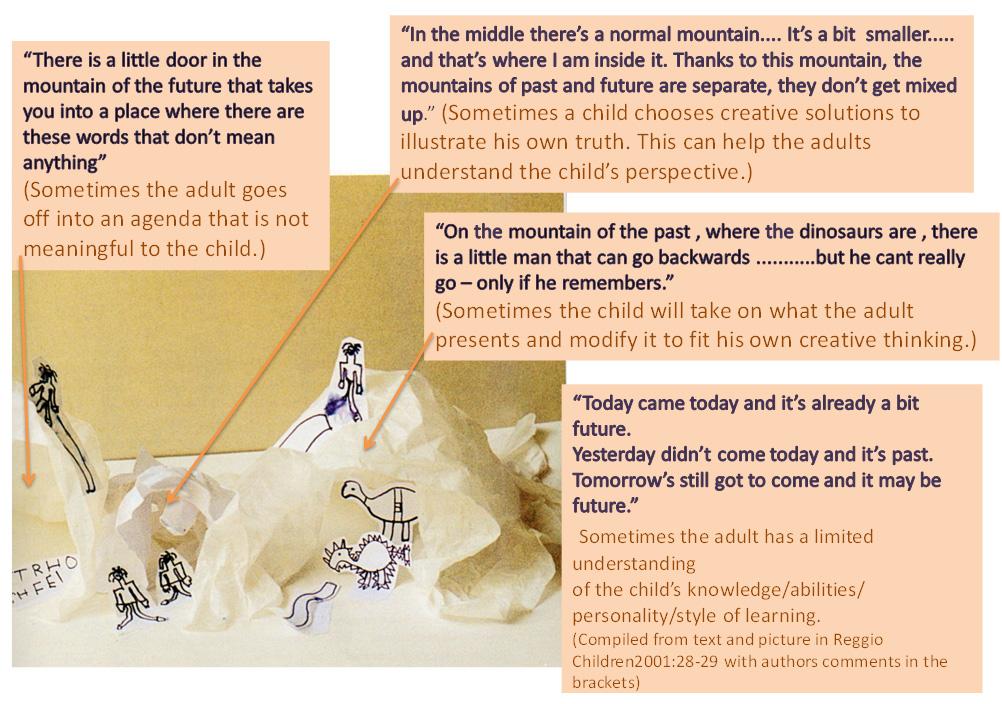
Using Various Media Resources
The Reggio approach uses various media resources in order to create different representational sequences and combinations that document (record) the children’s creative activity and present opportunities for reflection, assessment and progressive development. The different materials and media technology engage the children in a personally meaningful context that connects to other meaningful experiences and integrates different intelligences (Gardner) within a creative focus. TheReggio approach implies that giving the children the freedom to choose where and with whom, to invest their curiosity, intelligence and their emotionsgenerates a richness of intellectual development within the context of informed and conceptualised thought, illustrated throughtwo and three dimensional construction. (Katz,Cesarone Ed.,1994:42-43) The Reggio approach appears to encourage the children to develop their personal skills of independence– using multiple systems of communication and open ended areas of choice to support children’s independent skills and thinkingwithin a philosophy that ‘any good creative and expedient work requires considerable discipline and obedience.’ (The School DVD:15) Cameron suggests that ‘whether freedom is negligence, risk, or independence is a central concern of our times.‘(Cited in Early Childhood,2005:26) ‘Where and how far practitioners can promote children’s independence or freedom and where that becomes “risk”, depend to a large extent on the waythese concepts are understood, not just within early childhood pedagogy but also in wider cultural understandings.’(Early Childhood,2005:26) When considering risk factors within the context of children’s social-emotional and physical environment, adultsneed to evaluate potential risks within the of promotion of learning and social development.They might need to consider the levels of expectation and independence related to standards of self-help, personal careand management of the ‘social risks of incurring peer or adult displeasure.........the boundary between care and lack of care may be pushed where independence is defined as freedom’. The adults’conceptual understanding of cultural aspects within the local and wider societies,knowledge of each child,and the parents’ views and expectations, may also influence individual assessments of safety and acceptable levels of intimate contact as physical reassurance. Independent thinking andfreedom to make choices may be considered in relation to how ‘restricting options for children’may ‘inhibit creativity’. The children’s endeavours when doing things for themselves may also naturally include some of the positive aspects that risk taking and making mistakes contribute towards children’s learning and development. ‘......this formulation of independence may be culturally specific......Risk is socially and culturally defined.’(Early Childhood,2005:24-26) The Reggio approach seems to giveunsupervised freedomsto the children (Lewin Benham,2006:28)and supports this with a strong emphasis onan awareness and understanding of the individual child’s needs and abilities; equality‘a precious form of mutual respect’;integration and communication with individual parents; ‘public visibility’ - integration with the local community, cultural and community resources(Children in Europe,2004:2&7);reflective strategies; and an unstructured timetable tend to support children working safely within their own range of ability while engaging in self-motivated activity.Reggio Pedagogy
The Reggio pedagogy integrates many previously pioneered theories of education and related psychology that emphasize children’s ‘problem solving ability and creative endeavour’. (Bernard,1965:93).| Qualities that are associated with creative learning:- | |
| Willingness to explore | Experimenting, |
| Curiosity | Enquiring |
| Play and flow | Playfulness |
| Concentration, involvement, immersion | Focus, |
| Confidence and self-esteem. Ownership | Initiating ideas. |
| Perseverance and resilience | Persistence |
| Collaboration and cooperation | Willingness to be involved |
| Imagination and Inventive ingenuity | Observations, making connections, prediction |
| Autonomy and choice | |
| Hypothesis, powerful thinking | |
| Independence and self motivation | |
| Sustained shared thinking | |
| Making connections, Reflective thinking | |
| Risk taking | |
| Joy and surprise | |
| Aesthetic sensitivity | |
| Wellbeing | (compiled from Bancroft,2007:19) |
The Reggio Pedagogy Integrates Other Previous Educational Theories
The Reggio pedagogy integrates many previously pioneered theories of education and related psychology that emphasize children’s ‘problem solving ability and creative endeavour’. (Bernard,1965: 93).| High/Scope – teachers are trained in specific skills and approaches that help children engage in and share their play/learning experiences and resolve their social disagreements and conflicts. * | The author noted that on a video recording of Reggio classroom activity where two children were arguing the teacher approached and organically, from his own natural disposition, engaged in an accurate example of the High/Scope approach to conflict resolution. * |
| Steiner- presented that imagination and creativity are the most essential aspects of play and learning during the children’s early years 3 to 7 | Children have free access to the art studio and resident artist as well as a specified and well equipped art and craft area within their own classroom. There is a strong emphasis on artistic creativity throughout the topics or themes that have captured both individually and collectively the children’s interest. A special a focus is placed on the production of displays illustrating the children’s activities and resulting work. |
| Montessori presented - children should be free within the classroom environment to choose activities and organize their own social interactions and communications and have open access to a garden area. | The children are free to move around the whole of the school campus integrating with children and adults freely. They have open access to a special communal area called the Piazza and an outdoor communal garden. |
| Vygotsky presents - the role of the teacher is to support the child’s learning within the ‘proximal zone of development’(PZD) supporting the child’s choice of activity and unique approach to the potential for learning within chosen activities. ‘... the process of socialisation....was rooted in the use of physical tools and symbols...especially language’ (cited in Gardner,1996:199) | Reggio teachers are encouraged to observe and record the children’s activities and thereby respond supportively to emergent themes of interest or enquiry, and appropriately support the children’s spontaneous interactions. The teacher tries to present enriched environmental choices that are initiated by the children’s own themes of interest and what they feel is appropriate to develop and in the way they want to develop it. Teacher lead activities and teacher initiated choices are considered an optional aspect of classroom activity. |
| Chomsky-presents that learning is dependent upon interactive communication, language development and social integration. | The design and plan of the schools that have been specially built illustrate an openness and connectedness within the different areas. The walls are often constructed of window glass down to the floor; children can go into the kitchen and talk to or help the cook. Media Technology is available to the children and facilitates revisiting, extended dialogue and discussion, reflection, memory etc. |
| Pinney-presented that young children ‘are their own best expert’ and given a supportive, caring environment they can successfully negotiate choices that will enhance their personal, social and educational development. She pioneered Creative Listening, Special Time and Child Directed Learning. | The adults facilitate child initiated learning – ‘the complex and multiple strategies’ that are necessary for sustaining children's authentic ‘knowledge-building processes’ and creativity. B26p132 Every child is an ‘exquisitely individual and personal entity...’ b10p34 |
| Bruner - the importance of languaged communication, social interaction and community and cultural experiences within children's learning experiences. | ‘Rather than focusing on the developing child as an autonomous learner, Reggio...... educators see education as a communal activity and sharing of culture through collaboration among children and also between children and teachers, who opened topics’ ‘to speculation and negotiation.’ B16P71 |
| The Early Years Foundation Stage - Elements of creativity set as principles within concepts of: a unique strong child; positive relationships; enabling environments; learning and development. (Bancroft,2007:9) | The creative value of many languages of expression is actively generated by ‘The 100 languages of children’(Bancroft,2007:14) Cites Loris Malaguzzi ‘in functional terms: order and measurement; time, things and nature; body and movement; speaking and words; messages, forms and media; self and others.’ (Katz,Cesarone,Eds.1994:50) |
A Yin and Yang Perspective
The differences within the Steiner and Reggio pedagogical approaches are considered by the author from a Yin and Yang perspective.| Steiner supporting a more Yin perspective (female) | Reggio presenting a more Yang perspective (male) |
| Considers child’s learning and creativity is boundless when supported by a growing knowledge and understanding of the natural world and creativity within organized rhythms of repetition and imitation. | Considers child’s learning through creativity is boundless when supported by a team of conscientiously supportive adults, who believe that learning takes place within an uninterrupted momentum of problem solving activity. |
| Embraces fantasy and imagination within the context of creative activity - music making, singing, story -telling and theatre. | Based on scientific, resourceful, exploratory approaches to creativity combined with critical/reflective evaluation |
| Encourages the child’s desires to be creative within a bounteous, natural homely environment with minimal science and technological input. | An environment rich in art, science and technology. |
| A strong emphasis on teaching by example and sharing through the arts - music, dance, non-competitive games and festive events. | A strong emphasis on the child as his own best expert. Using media systems to document and reflect creativity and provide informal feedback. |
| Considers the child as a seedling that adults and communities need to hold in a protective and nurturing environment. | Considers the child as a young citizens within a community of people with whom the teachers, resident artist and staff engage freely as individuals and co-operatively as a team. |
| Emphasizes environmental opportunities and organized interactive activities for the learning of coordination, movement and balance through foundation art and craft skills, playing musical instruments, songs, Eurhythmy, skipping and clapping games, and non-competitive sports. | Emphasizes the importance of supporting children’s right to be :- motivated by curiosity active explorers creators and inventors (creatively representing their knowledge and understanding of the worldly environment.) |
| Encourages the child’s:- - individual personality, - abilities and interests - aesthetic appreciation and creative expression within a community based emphasis on artistic, social and cultural foundations. | Presents the school environment as a child centred microcosm of the community and world around. Giving a community based emphasis on artistic, social and cultural foundations. The whole community is deeply committed to an ethos of love, respect and care. (Katz ,Cesarone,Eds. 1994:18) |
| Teachers are encouraged to use repetition, revisiting, review and presentation as foundations within the play and learn curriculum. | Documentation is considered an important part of both the adults’ and the children’s in school and out of school activity. |
Adults share their personal knowledge and experience through their wider access to resources,
‘...a process that acknowledges our need as individuals and as a society to engage in a co-operative learning adventure with others, both children and adults.’ (Katz,Cesarone Ed.,1994:36) When the children were sharing an interest in being tall, being up high, the teachers created a display board of pictures of tall buildings from Seattle where the school is located. The children built a cityscape right underneath the pictures of the tall buildings presented as a wall landscape created by the adult. Later a mirrored platform was presented.The children built a sky scraper on this and enjoyed the reflective aspect that extended their structure into a new perspective.As the children built a physical structure on the mirror, the building almost doubled in height.(Frazer, Gestwiki,Ed. 2002:205)Inappropriate adult input can be ignored:-
Listening to the children’s conversations the teachers hypothesized that a possible next path might be birds, so they brought in branches, nests and little bird figures. ‘But continued careful attention to the playconvinced them (the adults) that this was not the direction to pursue.......the (childrens’) play was still about being tall, being up high’ (Frazer, Gestwiki,Ed. 2002:205) Extending investigation into the community. Emergent, open ended, ‘child initiated, adult framed’. (100 Voices: DVD) Example: The teachers decided to extend this theme of investigation into the communityand they arranged to visit a water tower in a nearby city park. This visit initiated the project into III dimensional creative work. ‘The teachers offered clay, and the children began to build the water tower brick by brick. For over a month, a number of children worked making the bricks and then using the bricks to build the water tower.’ It was hard, painstaking work but the children were really motivated.‘ ...co-constructing as group members learning from one another’ Interactions between children and either an adult or a child who is more confident act as scaffolding to nudge children to go beyond what they can achieve on their own.’ (Frazer, Gestwiki,Ed. 2002: 94, 206-207,66) Integrating II and III dimensional representation As they built, they compared their sketches and referred to the drawings like blueprints. (Frazer, Gestwiki,Ed. 2002:207) The Reggio approach incorporates the use of cameras as a natural way for children to express themselves and review their projects of activity. For the adults cameras are also considered useful for recording detailed observation and assessment. In contrast to this Steiner kindergartens present that media technology is considered inappropriate within the early years and lower-school classes. The use of cameras also presents questions around the moral issues related to the children’s right to a camera free play and learn environment. Furthermore, teachers and children may use the camera in situations where a more intimate, multisensory approach to listening and observation could be of greater benefit to one or more individuals. Also, the adult operating the camera may miss a potential for spontaneous interaction that could initiate a more comprehensive understanding of the child/ren’s perspective. Finally, there is the issue of adult responsibility for discerning the appropriate environment, time, place and audience for viewing camera recorded documentation. (Early Childhood,2005:28& 32) Engaging in an emergent curriculum of creative activity. The High/Scope application of plan – do – review appears to have been reversed within the Reggio approach as follows:-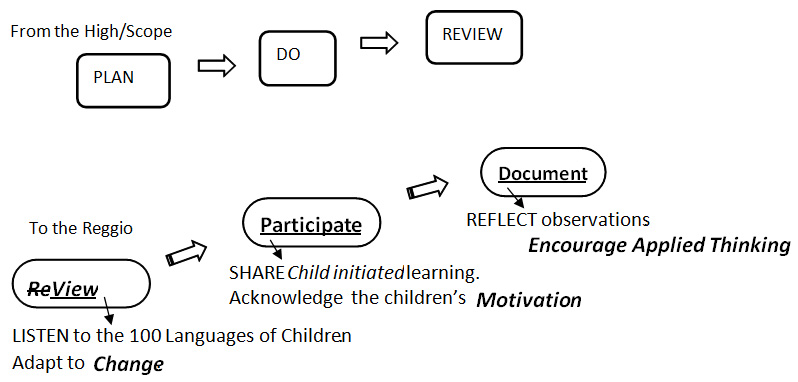 The Reggio approach presentschanging the environment to meet the child/children’s chosen areas of interest and enquiry. Learning differences, interests, abilities and disabilities, potential, physical development,personality and previous experience are all considered creative aspects within a child’s individual preferencesand learning style. The child himself is considered ‘the builder and main protagonist of his life and his learning processes.’(Reggio Children,2000:8)
When facilitating children learning through creative activity, Reggio teachers also appear to successfully integrate the influences ofChange, Motivation, and Applied Thinking .
The Reggio approach presentschanging the environment to meet the child/children’s chosen areas of interest and enquiry. Learning differences, interests, abilities and disabilities, potential, physical development,personality and previous experience are all considered creative aspects within a child’s individual preferencesand learning style. The child himself is considered ‘the builder and main protagonist of his life and his learning processes.’(Reggio Children,2000:8)
When facilitating children learning through creative activity, Reggio teachers also appear to successfully integrate the influences ofChange, Motivation, and Applied Thinking .
Celebrating Change
Reggio teachers appear to creatively relate to elements and influences that facilitate change -acknowledging that changes may also be implemented by problem solving processes and learning to support, to nourish, to help what is already growing within the child. ‘By surrendering our personal insistence to the larger current of meaningful change.’ (Hellinger 2007:184)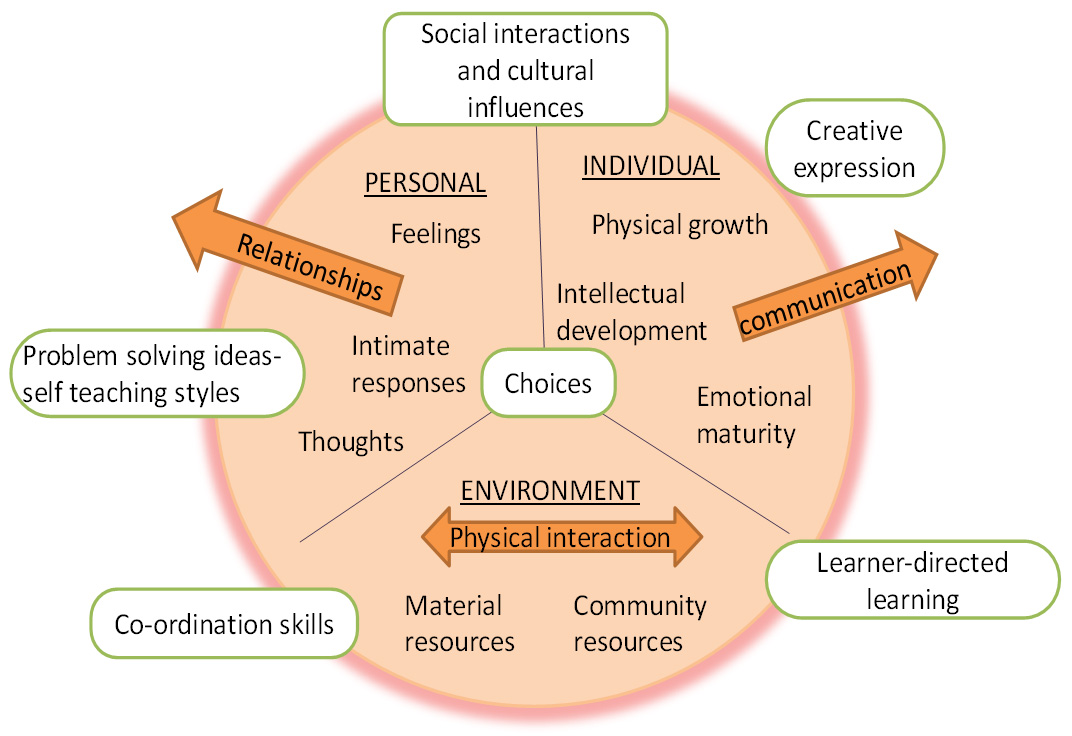 The Reggio environment appears to encourage everyone to feel comfortable with the unpredictable. This also supports personal investigation, discovery, shared learning experiences, and respects the children’s need to revisit their learning experience and create continuity within a broad spectrum of flexibility and movements of change. (Early Childhood,2005:19&14)
The Reggio environment appears to encourage everyone to feel comfortable with the unpredictable. This also supports personal investigation, discovery, shared learning experiences, and respects the children’s need to revisit their learning experience and create continuity within a broad spectrum of flexibility and movements of change. (Early Childhood,2005:19&14)
Motivation
During the early years motivation appears to be initiated by ‘curiosity, wonder and enthusiasm.’(Katz,Cesarone Ed.,1994:50) This initiates further development as illustrated in the author’s chart below, where each stage incorporates an integration of the previous stages. The chart also illustrates the inter-dependence between motivation and the development of complex thinking within children’s creative play.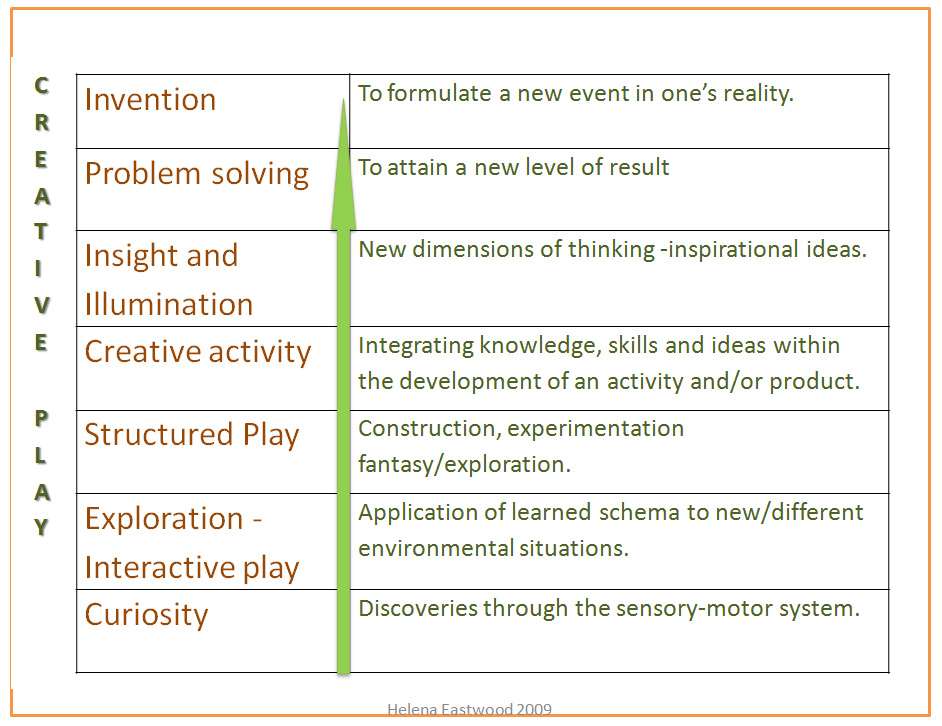 ‘....describing the hundred languages of expression, Malaguzzi recognized all the many different ways in which children interpret the world and represent their ideas and theories.’ (Thornton &Brunton 2005:9)
‘....describing the hundred languages of expression, Malaguzzi recognized all the many different ways in which children interpret the world and represent their ideas and theories.’ (Thornton &Brunton 2005:9)
Thinking Processes
This chart presents inter-related aspects that contribute to the development of inner courage, confidence, enthusiasm and a joyful disposition also appear to influence children’sconnections between ideas and things - a “divergent thought” that strays from any kind of coding - belonging strictly to the method of procedure in the consciousness of all children.’ (Reggio Children2001:57)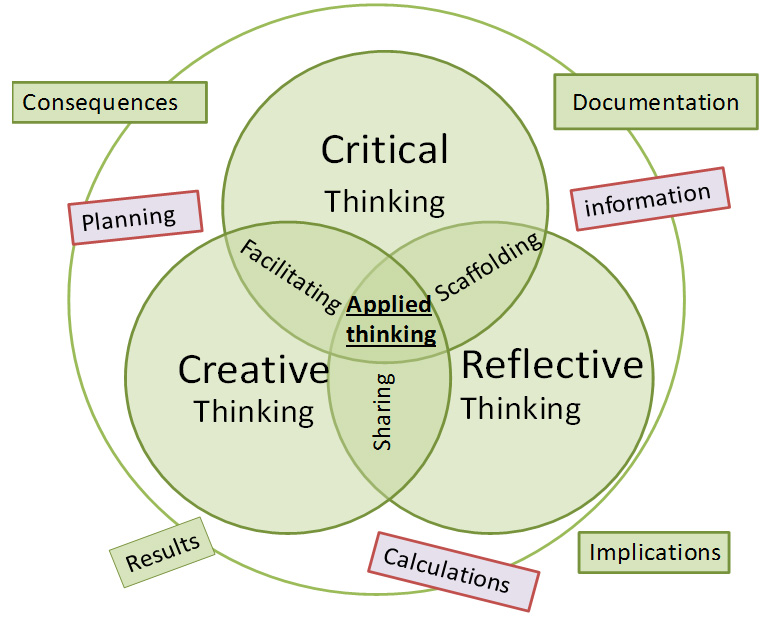 Creativity in the sense of the ability to produce ideas or new things but also to find new connections between ideas and things - a “divergent thought” that strays from a any kind of coding - belonging strictly to the method of procedure in the consciousness of all children.’
(creativity related to divergent thinking as opposed to the aesthetics of our present and practical reality.)
Creativity in the sense of the ability to produce ideas or new things but also to find new
The topic/project approach encourages each child to creatively design his/her own learning style and expression of creative activity. Where by individual attributes are combined in an infinite variety of activity initiated by the individuals chosen social and environmental relationships and ‘The complexities of Human Potential’illustrated by the author as follows:
Creativity in the sense of the ability to produce ideas or new things but also to find new connections between ideas and things - a “divergent thought” that strays from a any kind of coding - belonging strictly to the method of procedure in the consciousness of all children.’
(creativity related to divergent thinking as opposed to the aesthetics of our present and practical reality.)
Creativity in the sense of the ability to produce ideas or new things but also to find new
The topic/project approach encourages each child to creatively design his/her own learning style and expression of creative activity. Where by individual attributes are combined in an infinite variety of activity initiated by the individuals chosen social and environmental relationships and ‘The complexities of Human Potential’illustrated by the author as follows:
Qualities associated with the Human Potential
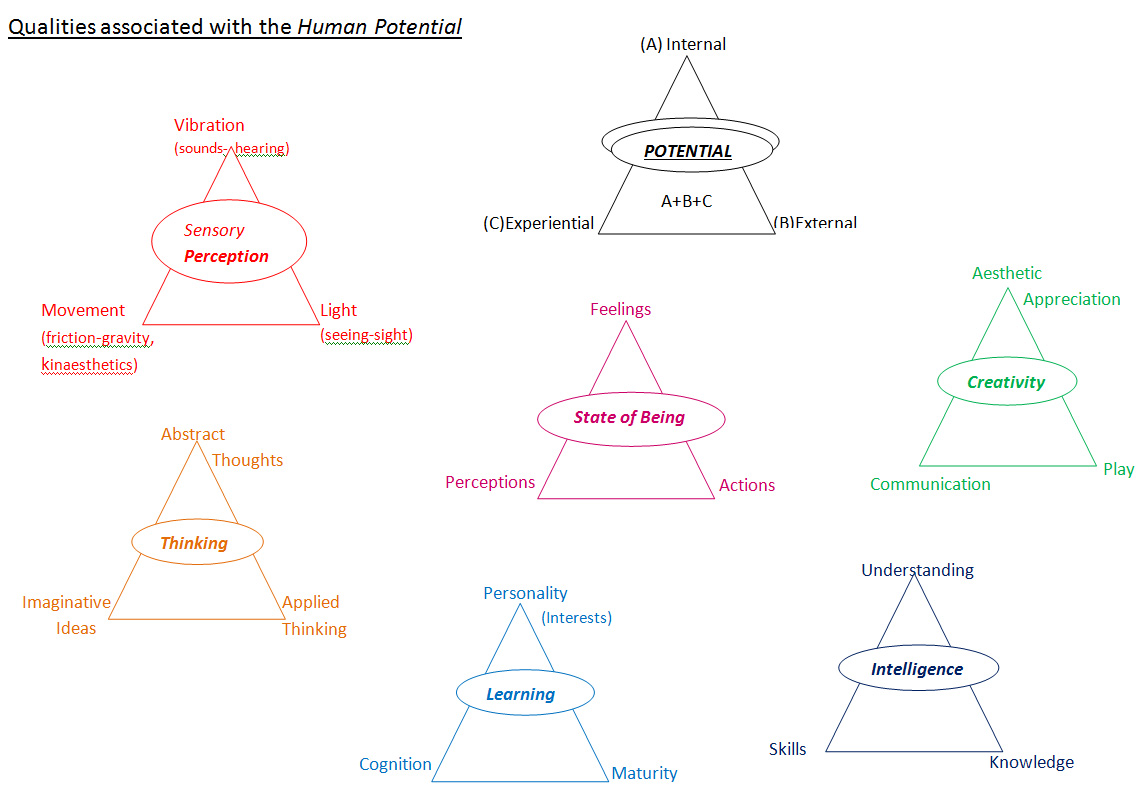
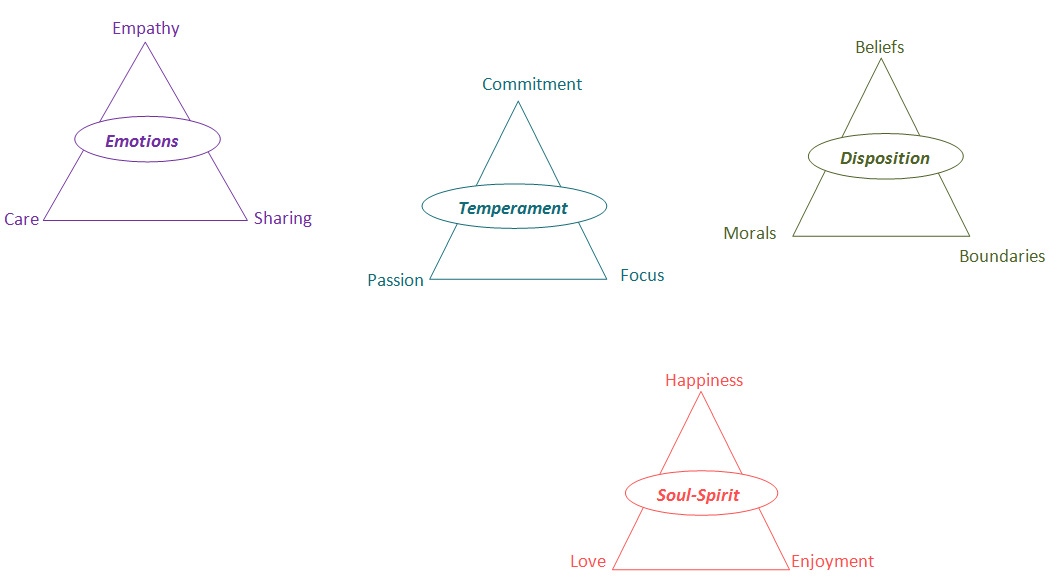
Conclusion
The adults in Reggio education work together with the children as a team and no one has a leadership status of superior authority and control. Warm respectfully collaboration on all levels of interaction encouragesan internal curriculum whereby strengths, personalities and perspectives can to come together, ‘often challenging each other to create a new perspective and knowledge’ alongside ‘ cognitive development through skills, knowledge, understanding and creativity while exploring an ‘excellence in early childhood education.’Authentic childhood p94-92’ [ The Reggio approach appears to have changed the premise of adults directing the children’s learning to one of scaffolding the children’s activities through environmental provisions and a collective theme of study combined with media documentation. ‘Interactions between children and either an adult or a child who is more confident act as scaffolding to nudge children to go beyond what they can achieve on their own.’ (Frazer, Gestwiki,Ed. 2002:66) .
Freedom within creative activity releases children from following
conventional thinking and structures of behaviour.
‘Frederica (age three) knows horses have four legs; she turns the piece of paper over and draws the other two legs on the reverse side’ (Rinaldi,2006:115) illustrating a cognitive level of expression bridging II and III dimensional creativity. Encouraging open ended questions of enquiry. ‘In the shadow of the zebra can you see the white stripes or the black stripes better?’ (Reggio Children,2000:89) Reggio teachers foster ‘the children’s competence by explicitly teaching techniques.’ One child was unable to successfully use a wire cutting tool, silently the adult intervened to demonstrate. On this occasion the adult chose to provide a demonstration without any verbal commentary. (Lewin Benham,2006:16) Supporting child-directed learning through an emergent curriculum of child initiated topics Reggio educators seem to be comprehensively relating Creativity to ‘the art of teaching’(Steiner,1982)within the Zone of Proximal Development.(Vygotsky citedin Frazer, Gestwiki,Ed. 2002:66) However, the author suggests that it is still the quality of adult intention that can influence the child’s development within the context of an evaluation and interpretation of the child’s world of passion, doing and well being. The adult’s internal assessment and integration of external and internal changes may thereby be related to the children’s playful inferences, implications, and subtle accommodation of adult judgments and values. Areas of concern could be considered within the controlling qualities of directing the children’s learning into an imposition disguised as a problem solving quest and/or unnatural levels of stimulus entertainment, presented as enrichment through an environmental impact artificially imported by the adults. However, the Reggio environment appears to encourage personal investigation, discovery, and shared learning experiences, and respects the children’s need to revisit their learning experience and create continuity within a broad spectrum of flexibility and creative activity. (Early Childhood,2005:19&14) It would appear that the Reggio schools have brought some degree of harmony to the seemingly polarised distinctions between child-initiated and adult-initiated curriculum, through a community approach where adults and children share an open ended topic style of progressive curriculum based on natural creativity and personal enquiry.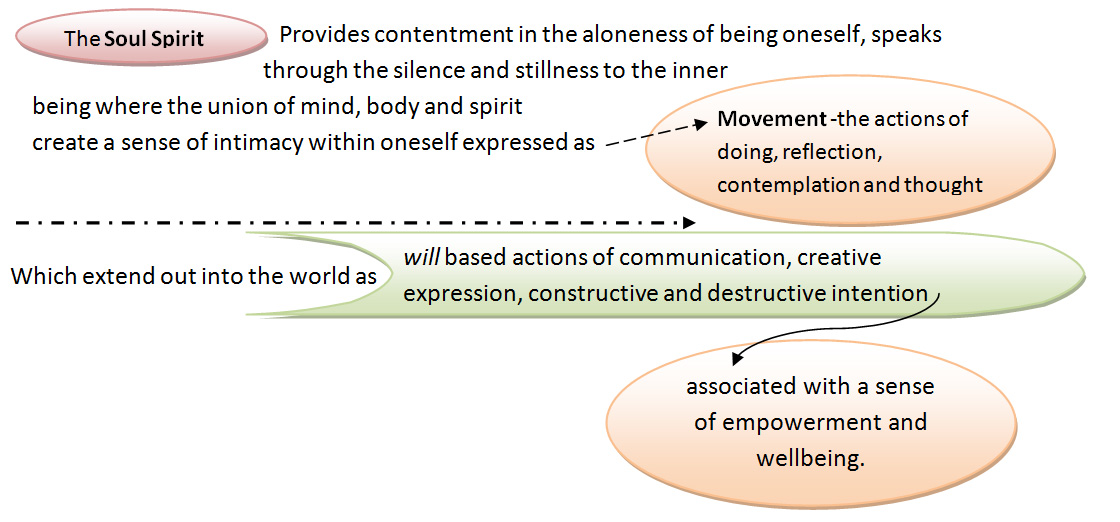 In the following chart the authorrelatesearly year’s development in three consecutive stages. Steiner, Montessori and Piaget present a strong differentiation between each stage, presented in the consecutive columns in the chart below. Whereas the Reggio approach appears to be successfully accommodating within the 3-6 years what is described above in the 6+ stage
In the following chart the authorrelatesearly year’s development in three consecutive stages. Steiner, Montessori and Piaget present a strong differentiation between each stage, presented in the consecutive columns in the chart below. Whereas the Reggio approach appears to be successfully accommodating within the 3-6 years what is described above in the 6+ stage
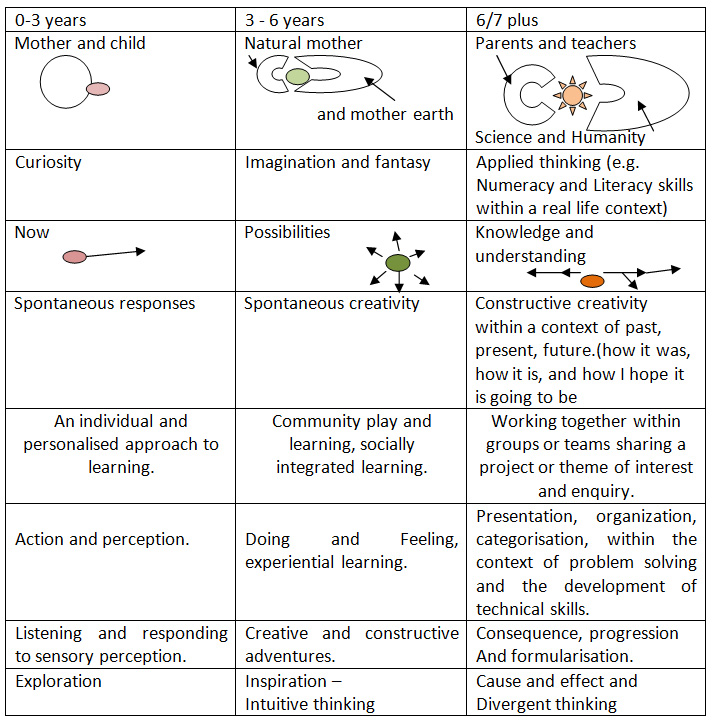
Steiner, Montessori and Piaget - Early Year’s Development
The success of the Reggio approach could be questioned in the light of the Steiner and Montessori pedagogy that present the more formal and academic approaches to learning, particularly studies of natural phenomena and associated sciences, should only begin after the age of six years. Whereby, the early years are held as a time of deep reverence and sensitivity to feelings and creative experiences as opposed to academic skills, worldly knowledge,ability and independence. Areas of cautionary concern for both the adults and the children appear to be:-- integrating freedom with a responsibility for safety;
- encouraging independence and self help without compromising standards of hygiene and healthcare;
- and inspiring personal confidence and authenticity,such that, unhealthy submission of an individual to a collective (ora collective to an individual) is minimised.
Conclusion
The essence of Reggio approach is summarised by the author in the chart below:-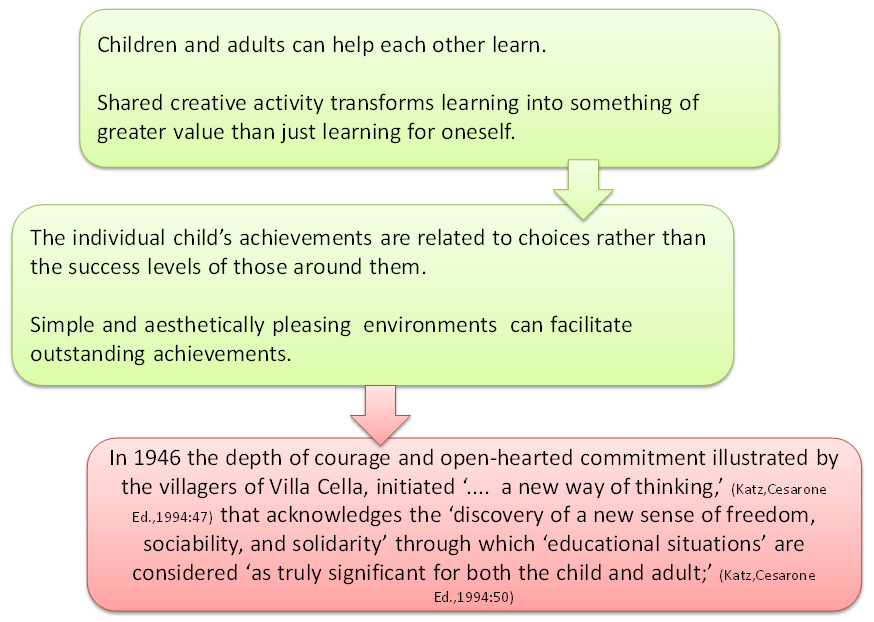 Reggio Emilia Bibliography
Abbot, L. &. Nutbrown, C. Experiencing Reggio Emilia: implications for the pre-school provision. Buckingham: Open University press, 2001.
Bancroft, S. Fawcett, M. Hay, P. 5x5x5 Researching Children Reseaching the World.Chippenham:5x5x5=Creativity, 2007.Barazzoni, B. Brick by Brick, English Ed. Reggio Emilia: Reggio Children, 2000.
Bernard, H.W. Psychology of Learning & Teaching. New York: McGraw-Hill,1965
Bruce, T. Cultivating creativity in babies toddlers and young children. London: Hodder & Stoughton, 2004.
Bruner, J. Beyond the Information Given, London: George, Allan & Unwin Ltd.,1974.
Ceppi, G. &Zini, M. Eds, Children, Spaces, Relations, Reggio Emilia: Reggio Children, 1998.
Curtis, D. & Carter, M. Learning Together with Young Children.St. Paul: Redleaf Press, 2008
De Bono, E. Teach Your Child How To Think. London: Viking, 1992.
De Bono, E. Six Thinking Hats. London: Penguin Book Ltd., 2000.
Duffy, B. Supporting Creativity and Imagination in the Early Years. London: Anvil Press, 1998.
Edizoni, J. Ed. Crossing Boundaries. Italy: Edizoni Junior, 2006
Edwards, C., Gandini,L. &Forman, G. 2nd Ed. The Hundred Languages of Children.London: Ablex Publishing, 1998.
Feeney, S. Galper, A. Seefeldt, C. Continuing Issues in Early Childhood Education 3rd Ed. Pearson Education: 2009.
Frazer, S. &Gestwicki C. Eds. Authentic childhood. Belmont: Delmar, 2002.
Gardner, H. Frames of Mind. Hammersmith: Fountain Press, 1993.
Gardner, C. H. &Kornhaber, M.A. & Wake, W.K. Intelligence: Multiple Perspectives, London: Harcourt Brace College Pub. 1996.
Gardner, H. Intelligence Reframed
Hellinger, B.With God in Mind.Hellinger Publications, 2007.
Horne, T. &Wootton, S. Teach Yourself – Train the Brain. Part 1. London: Hodder Education, 2007
Hughes, F.P. Children, Play and Development.Massechussetts: Allyn& Bacon, 1999.
Katz L. G. &Cesarone Eds. Reflections on the Reggio Emilia approach. Illinois: ERIC, 1994.
Lewin-Benham, A. Possible Schools, the Reggio Approach to Urban Education.London: Teachers College Press, 2006.
Macintyre, C. Enhancing Learning Through Play. London: David Fulton, 2001.
MacNaughton, G. & Williams, G. Teaching Young Children: choices in theory. Berkshire: Open University Press, 2004.
Manning, K. Structuring Play in the Early Years at School. London: Ward lock educational, 1977.
Meadows, S. The child as Thinker 2nd Ed. London: Routledge, 2006.
Megre, V. A Space of love.The Ringing Cedars Press, 2005.
Overall, L. Supporting Children’s Learning, a guide for teaching assistants. London: Sage, 2007.
Piaget, J. &Inhelder, B.The Psychology of the Child. London: Routledge & Kegan Paul. 1969.
Pollard, A. Reflective Teaching. London: Continuum, 2002.
Reggio Children of the Diana & Gulliver Preschools.Everything has a shadow except ants, 2nd Ed. Reggio Emilia: Reggio Children, 2000.
Reggio Children of the Fiastri and RodariMuniciple Preschools of Sant’llariod’Enza, The Future is a Lovely Day. Reggio Emilia: Reggio Children, 2001.
Reggio Children from the Diana School, ADVISORIES.Reggio Emilia: Reggio Children, 2002.
Rinaldi, C. In dialogue with Reggio Emilia. London: Routledge, 2006
Thornton, L. &Brunton, P. Understanding the Reggio Approach. London: David Fulton, 2005.
Williams, J. Promoting independent learning in the primary classroom. Buckingham: Open University Press, 2003.
Journals
Children in Europe. March 2004. Edinburgh: Children in Scotland, 2004.
Early Childhood. Folio 9:2005
Nursery World 5th Feb 2004
DVDs
Buzan, T.& Griffiths, C. The story of Mind Mapping.
Gilbert, P. Ed., 100 Voices – 5x5x5 Researching Children Researching the World. Bath: 5x5x5 Creativity n. d.
The school - Humanities new future- www. TEKOS.org Dreams Fulfilment LLC 2009
Reggio Emilia Bibliography
Abbot, L. &. Nutbrown, C. Experiencing Reggio Emilia: implications for the pre-school provision. Buckingham: Open University press, 2001.
Bancroft, S. Fawcett, M. Hay, P. 5x5x5 Researching Children Reseaching the World.Chippenham:5x5x5=Creativity, 2007.Barazzoni, B. Brick by Brick, English Ed. Reggio Emilia: Reggio Children, 2000.
Bernard, H.W. Psychology of Learning & Teaching. New York: McGraw-Hill,1965
Bruce, T. Cultivating creativity in babies toddlers and young children. London: Hodder & Stoughton, 2004.
Bruner, J. Beyond the Information Given, London: George, Allan & Unwin Ltd.,1974.
Ceppi, G. &Zini, M. Eds, Children, Spaces, Relations, Reggio Emilia: Reggio Children, 1998.
Curtis, D. & Carter, M. Learning Together with Young Children.St. Paul: Redleaf Press, 2008
De Bono, E. Teach Your Child How To Think. London: Viking, 1992.
De Bono, E. Six Thinking Hats. London: Penguin Book Ltd., 2000.
Duffy, B. Supporting Creativity and Imagination in the Early Years. London: Anvil Press, 1998.
Edizoni, J. Ed. Crossing Boundaries. Italy: Edizoni Junior, 2006
Edwards, C., Gandini,L. &Forman, G. 2nd Ed. The Hundred Languages of Children.London: Ablex Publishing, 1998.
Feeney, S. Galper, A. Seefeldt, C. Continuing Issues in Early Childhood Education 3rd Ed. Pearson Education: 2009.
Frazer, S. &Gestwicki C. Eds. Authentic childhood. Belmont: Delmar, 2002.
Gardner, H. Frames of Mind. Hammersmith: Fountain Press, 1993.
Gardner, C. H. &Kornhaber, M.A. & Wake, W.K. Intelligence: Multiple Perspectives, London: Harcourt Brace College Pub. 1996.
Gardner, H. Intelligence Reframed
Hellinger, B.With God in Mind.Hellinger Publications, 2007.
Horne, T. &Wootton, S. Teach Yourself – Train the Brain. Part 1. London: Hodder Education, 2007
Hughes, F.P. Children, Play and Development.Massechussetts: Allyn& Bacon, 1999.
Katz L. G. &Cesarone Eds. Reflections on the Reggio Emilia approach. Illinois: ERIC, 1994.
Lewin-Benham, A. Possible Schools, the Reggio Approach to Urban Education.London: Teachers College Press, 2006.
Macintyre, C. Enhancing Learning Through Play. London: David Fulton, 2001.
MacNaughton, G. & Williams, G. Teaching Young Children: choices in theory. Berkshire: Open University Press, 2004.
Manning, K. Structuring Play in the Early Years at School. London: Ward lock educational, 1977.
Meadows, S. The child as Thinker 2nd Ed. London: Routledge, 2006.
Megre, V. A Space of love.The Ringing Cedars Press, 2005.
Overall, L. Supporting Children’s Learning, a guide for teaching assistants. London: Sage, 2007.
Piaget, J. &Inhelder, B.The Psychology of the Child. London: Routledge & Kegan Paul. 1969.
Pollard, A. Reflective Teaching. London: Continuum, 2002.
Reggio Children of the Diana & Gulliver Preschools.Everything has a shadow except ants, 2nd Ed. Reggio Emilia: Reggio Children, 2000.
Reggio Children of the Fiastri and RodariMuniciple Preschools of Sant’llariod’Enza, The Future is a Lovely Day. Reggio Emilia: Reggio Children, 2001.
Reggio Children from the Diana School, ADVISORIES.Reggio Emilia: Reggio Children, 2002.
Rinaldi, C. In dialogue with Reggio Emilia. London: Routledge, 2006
Thornton, L. &Brunton, P. Understanding the Reggio Approach. London: David Fulton, 2005.
Williams, J. Promoting independent learning in the primary classroom. Buckingham: Open University Press, 2003.
Journals
Children in Europe. March 2004. Edinburgh: Children in Scotland, 2004.
Early Childhood. Folio 9:2005
Nursery World 5th Feb 2004
DVDs
Buzan, T.& Griffiths, C. The story of Mind Mapping.
Gilbert, P. Ed., 100 Voices – 5x5x5 Researching Children Researching the World. Bath: 5x5x5 Creativity n. d.
The school - Humanities new future- www. TEKOS.org Dreams Fulfilment LLC 2009Rudolf Steiner Born Austria / Hungary Border 1861 – 1925
- A ‘typical country boy’ whose father was the village stationmaster.
- At 18 attended Technical University Vienna
- Interested in Goethe’s: theory of colour; the interplay between the material and spiritual worlds.
- 1884-1890 Outstanding success tutoring Otto, ineducable due to his hydrocephalic condition.
- 1913 Designs and builds the Goetheanum building and initiates the Steiner Anthroposophical Society.
- 1914 Organises a school for children at the cigarette factory in Stuttgart.
- 1919 Steiner was lecturing intensively throughout the continent on issues based on his ‘three fold social order’ and ‘cultural deprivation’.
Maria Montessori Born in Ancona, Italy. 1870 -1952
- First girl to attended a ‘boys technical school’ and become an engineer.
- In 1896: first woman in Italy to qualify as a Doctor of Medicine.
- In 1899-1901: director of the Orthophrenic school for ‘mentally disabled children’.
- Montessori studied the work of Jean Itard’s and Edouard Seguin,
- 1904 was appointed Professor of Pedagogic Anthropology at Rome University
- In 1906: Casa dei Bambini a school for fifty children from the San Lorenzo slum in Rome.
- Later classroom with a glass wall at the International Exposition in San Francisco. Montessori schools and societies in USA, Europe and India.
Freedom to play - child directed learning
- Motivation Perception
- Creative activity Comprehension
- Curiosity Memory
- Exploration & experimentation
- Social interaction
- Concentration (focus and attention)
- Perseverance (repetition and patience)
- Intellectual interest (curiosity and investigation)
- knowledge (zealous conservation of all objects)
- Aspiration to know, love and serve.
(Montessori, 1988: 197-201)
MONTESSORI objectives
- Love of order
- Love of work
- Attachment to reality
- Love of silence and working alone
- Obedience
- A power to act from real choice
- Independence and initiative
- Self-discipline
- Joy
- Cooperation with peers
Riley’s description of Montessori objectives (Riley,2003:21-22)
STEINER ethos
- Love of nature and aesthetic creativity
- Love of purposeful activity
- Attachment to pattern and rhythm
- Love of singing, music and movement
- Loyalty and desire to please
- A power to act from personal choice
- Self-directed learning through play
- Self-discipline
- Passion for creativity
- Learning together
The aesthetic need for beauty, order, symmetry, and completion. ’It appears only in some mature individuals, but is frequently seen in healthy children.’ (Bernard,1965:243 Citing Maslow’s ‘order of needs’6th)
Love of order
Montessori describes the young child’s need for order and stability as a genuine necessity because he is ‘constructing himself out of the elements of the environment‘
The child ‘is striving incessantly to bring this bewildering universe, as he knows it, into some sort of order’ (Standing,1962:126 (Montessori,1966:41;L.M.C,1982:13-14)
Love of nature and aesthetics
Biodynamic gardening, growing and harvesting activities.
Natural environments nurture the child’s soul and spirit.
....when stating that we wish to educate the heart of the child and not only his intellect , we should ask ourselves how best we can meet this challenge.(Steiner,1988:24)
‘The law of nature is order and when order comes of itself, we know that we have re- entered the order of the universe.’ (Montessori,1998:261)


Love of work
Young children have critical learning periods that initiate learning behaviour. Montessori defines these ‘sensitive periods’ as: order; senses; language; walking; small objects; and social aspects of life.
Successful completion of tasks will normalise a child’s powers of concentration, intelligence and self-discipline during this early formative period.
This love for his environment makes the child treat it with great care and handle everything in it with the utmost delicacy.’ (Monssori, 1988:200)
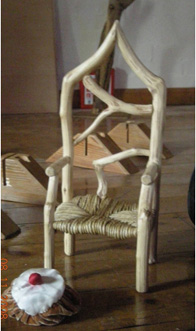
Love of creative activity
Natural rhythms and sensorial experiences from daily life
Inner spiritual forces facilitate that the child’s imitative response is an entirely individual artistic impulses unfolding their own soul activity.
‘The art of education must proceed from life itself and not from abstract scientific thought’ (Steiner, 1988:5)
and we must protect the child from being absorbed too strongly or too rapidly by the outer world.(Steiner,1982:29,46,47)
From approximately 3 to 7, the child is consciously developing optimum levels of physical sensory-motor differentiation, learning through imitation, and an open hearted willingness to please.
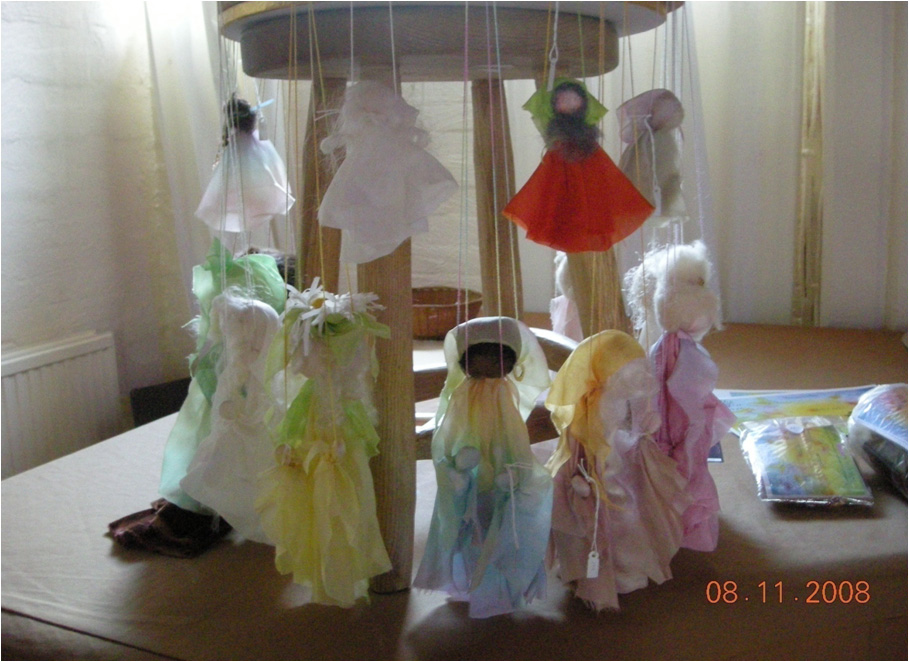

‘And so the task of a kindergarten teacher is to adjust work taken from daily life so that it becomes suitable for the children’s play activities.’ (Steiner,1988:81)
Attachment to reality
Unity of the soul and body is expressed through ‘voluntary effort under the conscious direction of the mind‘, which emanates as a ‘perfection that is individual and personal ‘ (Standing,1962:212)
Freedom to choose how, when and with whom they ‘work’ without any directed length of time.
Attachment to pattern and rhythm
A child’s learning is facilitated by the teacher’s presentation of rhythmic activities and routines
The child learns through his sense of feeling which is perceived within the bodies ‘rhythmic system’(Steiner,1982:37)
Providing the opportunity to ‘imitate life in a simple and wholesome way.’ (Steiner,1988:81)
Love of silence and working alone
‘This intellectual possessiveness shows itself when the child is so strongly attracted by his environment that we may almost say he is ‘in love’ with it.’ (Montessori, 1988:200)
Silence predisposes the soul for certain inner experiences. “ You are not the same after the silence as you were before it.”
(Standing, 1962:226)
Love of singing, music, drama movement and dance
Aesthetic and artistic experiences appear to be strongly influenced by the social aspects of music making, singing and live storytelling and associated theatrical presentation.
Steiner’s ethos is to present an environment that nourishes the child’s imagination and nurtures his artistic creativity throughout the curriculum.
Steiner suggests that what comes from the environment inwardly influences ‘the orientation of a person’s thought life’ (Steiner,1988:37)
Bernard presents that when ‘one is most unlovable, he is most in need of love.’(1965:247)
Obedience
The child finds independence through organised learning.
Mutual appreciation and respect between teacher and children
Montessori the teacher the directress. However, this does not imply that she wishes the children to copy her actions or that she is there to correct a child if he does something wrong.
Loyalty and desire to please
The child is entirely given over to subconscious wisdom, has a natural disposition to intuitively comprehend and integrate all his sensory experiences
and naturally absorbs the inherent moral and cultural influences. (Steiner,1988:76)
Mutual admiration and respect for the guardianship role of the teacher
When the teacher can relate to the individual soul nature of each child, she will gain powerful feelings of support ‘for teaching and educating the child lovingly’ and the children will respond with ‘loyal affection and devotion’(Steiner,1982:58 &60).
Child’s describes Steiner’s ethos as ‘Imbue thyself with the power of imagination’.... ‘Have courage for the truth’..and.... ‘Sharpen thy feeling for responsibility of soul.’ (Childs,1995: 61)
A power to act from real choice
Montessori presents that the children should be free to move about and express themselves spontaneously within the classroom throughout the day, and that this helps the children learn ‘active discipline’ through their own inner mastery of themselves.
A power to act from personal choice
Steiner kindergarten teachers focus on a joyful and child centred approach,
where reconceived goals, plans, gains and ideas are secondary to the primary whole hearted celebration of creative living and spontaneous doing;
where control of error has no place beyond practical applications related to the process of play, and learning is a ‘wholly organic’ process. (Steiner,1982:34)
The importance of imitation for the child during the early years. Unlike copying, imitation intrinsically involves the child’s desire to initiate a sensory experience, ‘enacted in deep earnest by the child in its play’ (Steiner,1988:80)
When the child’s freedom can be directed by the teacher’s careful preparation and organisation of the environment
Independence and initiative
Play is a child’s ‘work’
Montessori emphasized the concrete aspects of living and doing.
She provided specialized concrete didactic apparatus with a structural control of error.
This equipment encouraged detailed sensory discrimination of size, shape, colour and shade, smell, sounds, musical tones and semi-tones.
Child-directed learning through play
Play is a natural inborn impulse
The Steiner Kindergarten provides natural and undefined materials which are considered supportive to free play and natural flowing creativity.
Which gives wide experiences and extensive opportunity for personal expression and intuitive exploration; thus expanding the learning experience beyond that which would have been gained by learning to perform a pre-structured activity and engage in consciously organized intellectual thinking.
Self-discipline
‘Without concentration it is the objects about him which possess the child.....But once his attention has been focused, he becomes his own master and can exert control over his world.’
Following the development of concentration comes perseverance when repetition consolidates the child’s ’ability to carry through what he has begun.’ (Montessori,1988:197-198.)
Self-discipline
Steiner presents that it is the enactment of the child’s will rather than intellect that formulates the child’s early learning.
Steiner suggests there is minimal need for correction at this age
because the children’s own desires and sense of aesthetic appreciation will facilitate assessment of results and of rhythms of routine, order and tidiness.
Both Montessori and Steiner encourage that boundaries should be presented in a way that is perceived as helpful to all rather than disciplinary action focused on a specific individual and/or their chosen activity.
Such that the abstract can be expressed and the concrete can be felt.
Joy
With the freedom to follow his own inner forces, the child will focus his attention not on things themselves, but on ‘the knowledge he derives from them.......
..... the child does not act from logic, he acts by nature.’ (Montessori, 1988:199)
Passionate enthusiasm
Steiner presents that it is the enactment of the child’s will rather than intellect that formulates the child’s early learning.
‘The child wants to be active simply out of an inborn and natural impulse. Play activity streams outward from within.’(Steiner, 1988:80)
‘.......factors essential for the future development of humankind are bringing to wider consciousness the knowledge that the human being is essentially spiritual in nature, and as such has spiritual needs,’ (Childs,1995:34)
Bernard when citing Maslow presents that ‘...when pupils feel that they are part of a group, desirable and purposeful learning activities are facilitated.’ (Bernard,1965:248)
Cooperation with peers
Individuals working together as a team, caring and supporting each other
Montessori suggests that children have a natural ability to relate to social behaviour objectively, together with the virtue of patience and a sense of morality that is founded in their desire for harmony.
Sharing and learning together
A specified group of children sharing as a small community with its own ‘home base’ The child is entirely given over to subconscious wisdom and has a natural disposition to intuitively comprehend and integrate all his sensory experiences and naturally absorbs the inherent moral and cultural influences. (Steiner,1988:76)
Rudolf Steiner Born Austria / Hungary border:1861 – 1925
- A ‘typical country boy’ whose father was the village stationmaster.
- At 18 attended Vienna Technical University
- Interested in Goethe’s: theory of colour; the interplay between the material and spiritual worlds.
- 1884-1890 Outstanding success tutoring Otto, ineducable due to his hydrocephalic condition.
- 1913 Designs and builds the Goetheanum building and initiates the Steiner Anthroposophical Society.
- 1914 Organises a school for children at the cigarette factory in Stuttgart.
- 1919 Steiner was lecturing intensively throughout the continent on issues based on his ‘three fold social order’ and ‘cultural deprivation’.
Maria Montessori Born in Ancona, Italy.: 1870 -1952
- First girl to attended a ‘boys technical school’ and become an engineer.
- In 1896: first woman in Italy to qualify as a Doctor of Medicine.
- In 1899-1901: director of the Orthophrenic school for ‘mentally disabled children’.
- Montessori studied the work of Jean Itard’s and Edouard Seguin,
- 1904 was appointed Professor of Pedagogic Anthropology at Rome University
- In 1906: Casa dei Bambini a school for fifty children from the San Lorenzo slum in Rome.
- Later classroom with a glass wall at the International Exposition in San Francisco.
- Montessori schools and societies in USA, Europe and India.
Open Questions
Shared learning experiences through open ended interactive questions:- How are you feeling? Can I help you? What would you like me to do? Would you like to tell me about........? Open questions are those that do not have a specified answer, they are notable for encouraging a personal response and review choices. They may invite and initiate personal and social responses, sharing of choices and ideas, the integration of past, present and future, spontaneous communication from genuine interest and/or social interaction. Open questions support and encourage:-- Generate consideration of environmental choices.
- Creative thinking and imagination
- Related social and environmental opportunities
- Personal and social responses sharing choices, ideas and the integration of past, present and future.
- Spontaneous communication from genuine interest and desire to share social interaction.
- Additional levels of consciousness.
Closed Questions
Closed questions are often loaded with judgment, e.g. ‘What’s the matter with you!!? ‘That was a stupid thing to do wasn’t it !!?’ ‘Your screaming is making me angry’. It is important that a child or person is not blamed for the other person’s emotional upset. Sharing in a simple and honest way about our feelings can be helpful for everyone concerned; e.g. ‘I’m feeling angry and right now I need to find/have a quiet space.’ This honest straight forward style of communication can help others to recognise and empathise. Thus the emotions one person senses in the other person can be acknowledged without an overwhelming sense of personal responsibility Closed Questions often require the description of factual knowledge and/or adult initiated ideas and social directives. They normally relate to specified knowledge and experience E.g. What is your dog’s name? Which is the biggest? What is the time? Etc. Closed Questions relate to specified knowledge and experience. For example: Is your dog called Tom? Do you want extra peas? Did you put your own shoes on today? etc. Closed questions can encourage logical thinking and memory skills; however they usually generate Yes or No answers. Yes answers can be more easily expanded into personalised and/or imaginative responses; e.g. Is that .....your blue hat? Yes, it’s my blue school hat. My mum said it had to be blue but I wanted a pink one, I don’t like the dark colour it is a sad colour...... Who gave you that lovely hat? My Granny gave me this hat she knitted it for my birthday and it is really warm. It has a soft cosy lining....... Does your dog like to play? Would you like anything extra? Are those shoes difficult to get on? Even the more open style of what, when, which, where, who, why, questions can be very limited when followed by the word ‘is’ i.e. what is ……when is ….etc.. No answers to closed questions do not generally encourage interactive social behaviour. Also, negative answers may disempower personal confidence and individuality.No answers tend to discourage personalised and/or imaginative responses and emphasis negative feelings. No answers tend to discourage personalised and/or imaginative responses. They can also generate ‘I don’t know’ responses and feelings of anxiety and inferiority. Questions that initiate No (negative) answers can be motivated by:-- A need to control,
- A negative judgement,
- A resistance to social interaction and communication,
- Unnecessary interference or unwanted interference.
